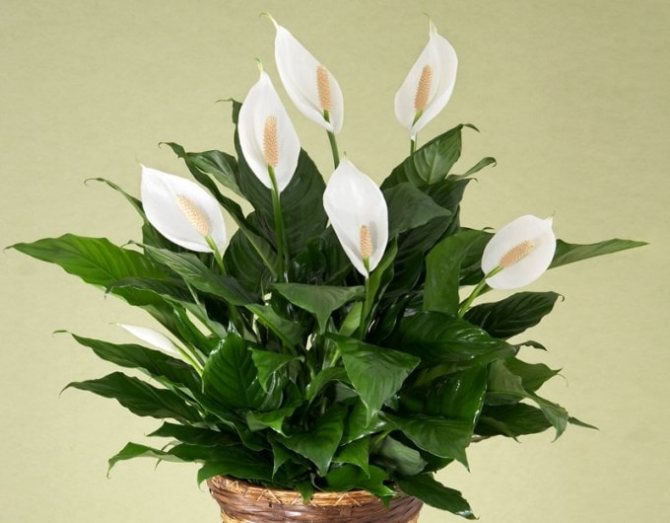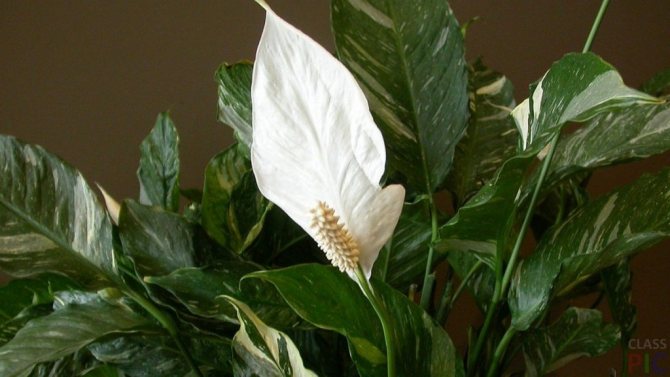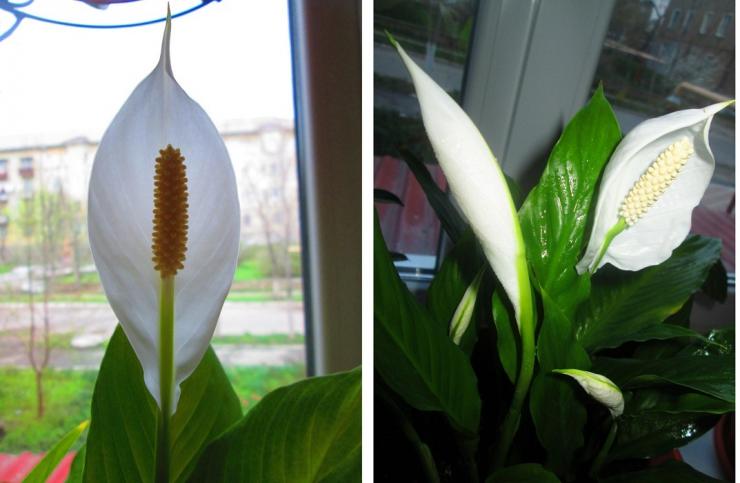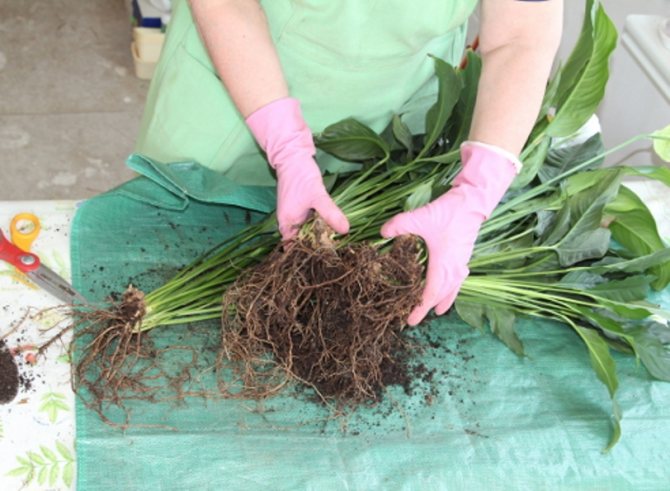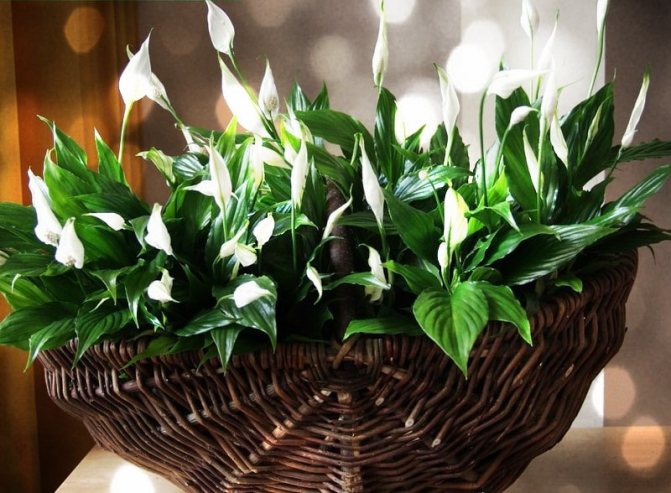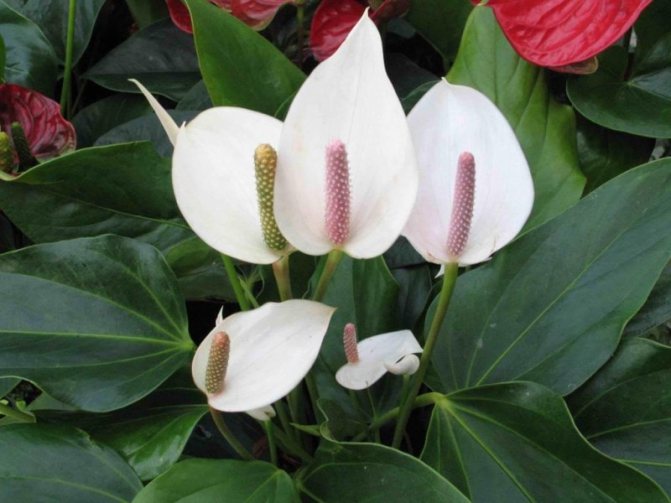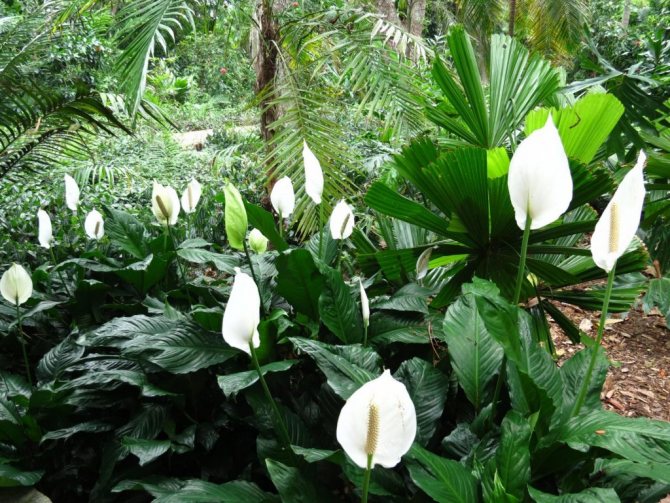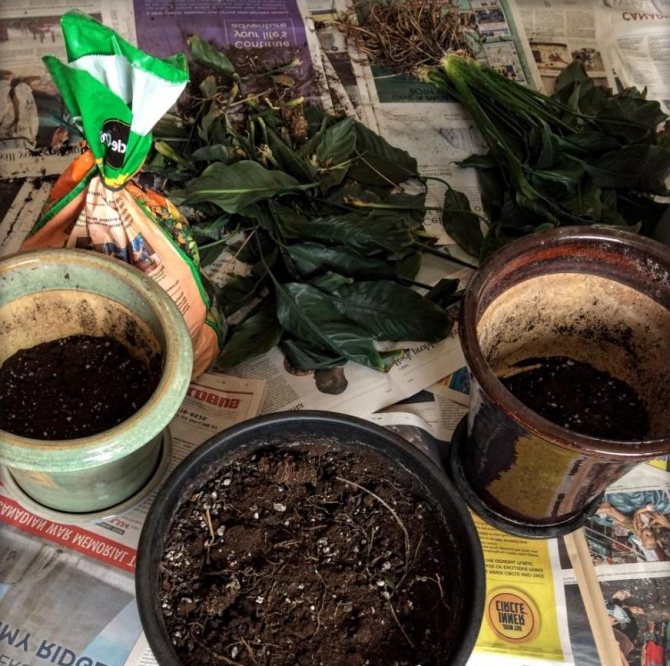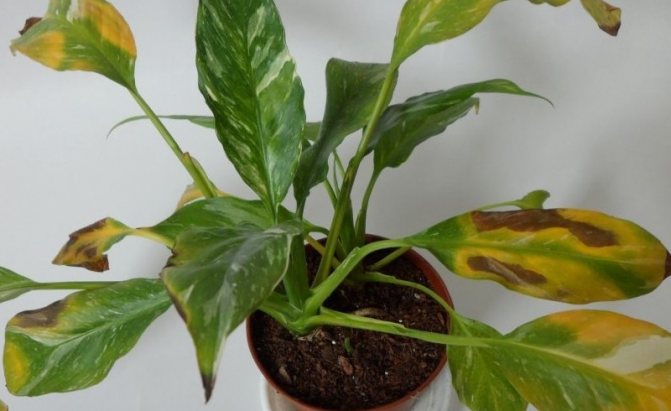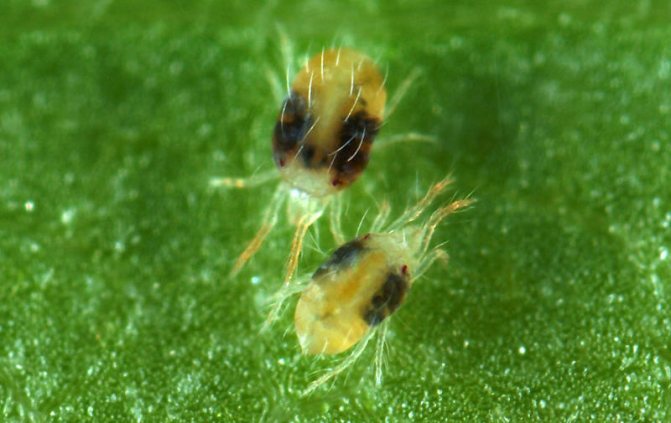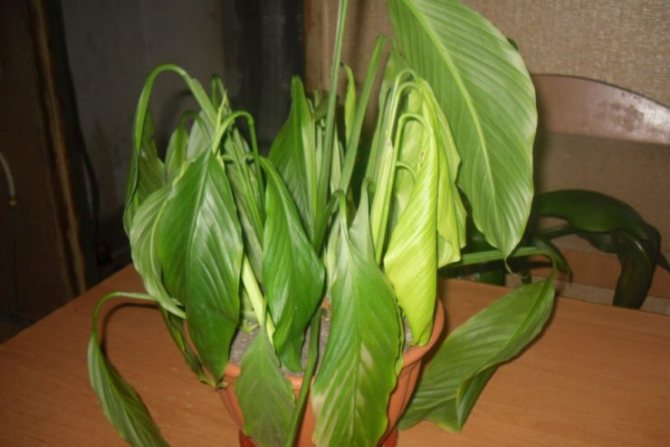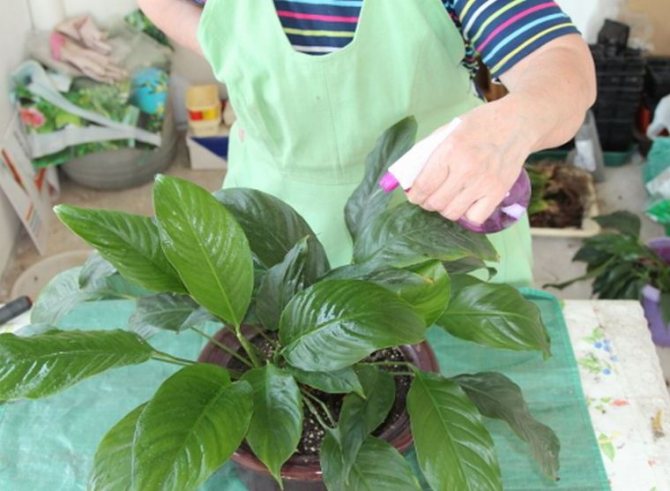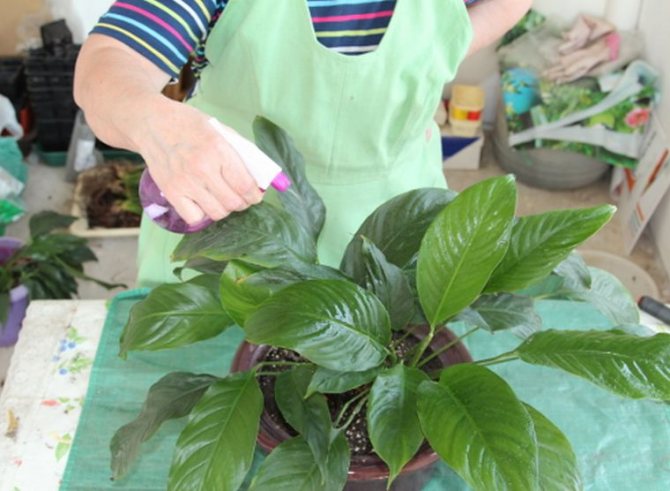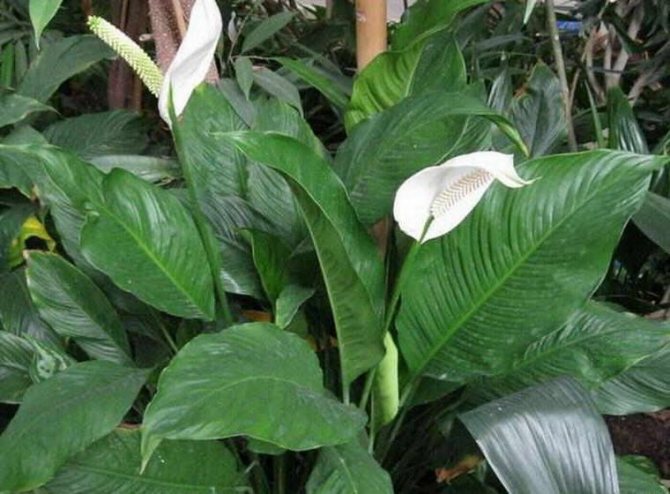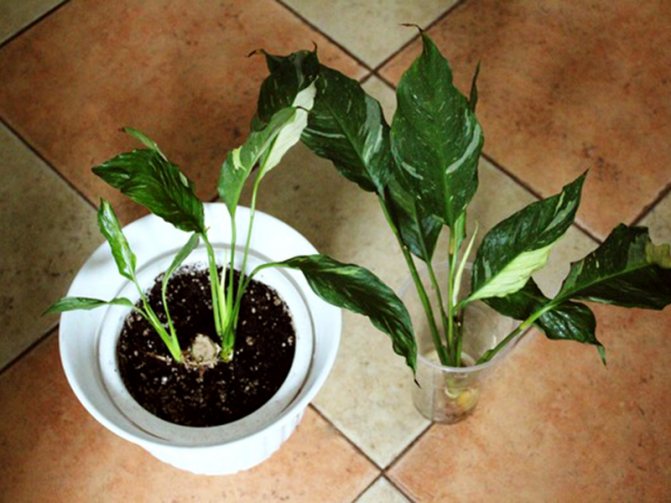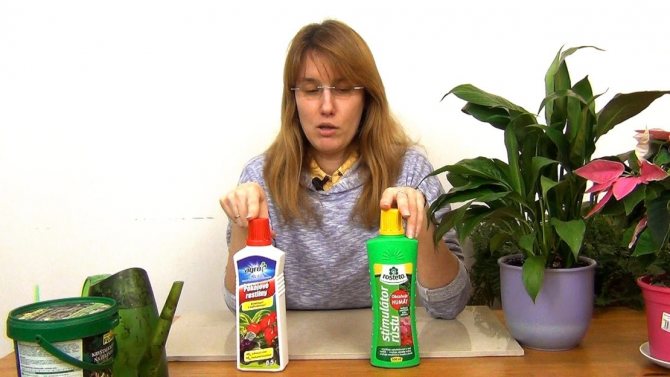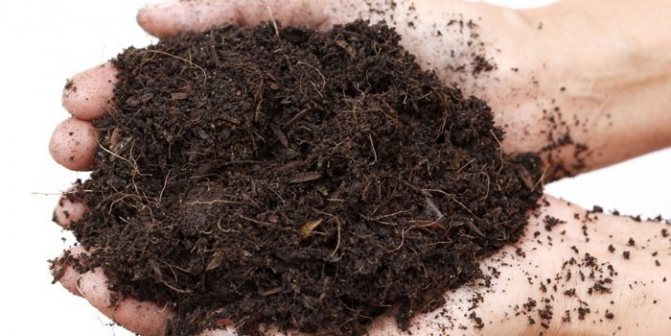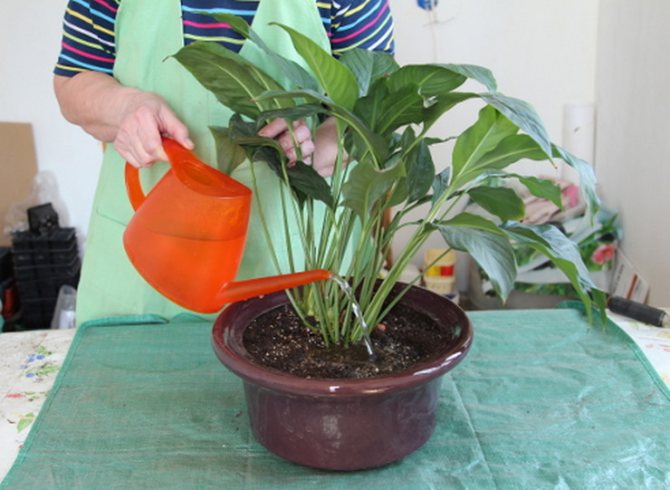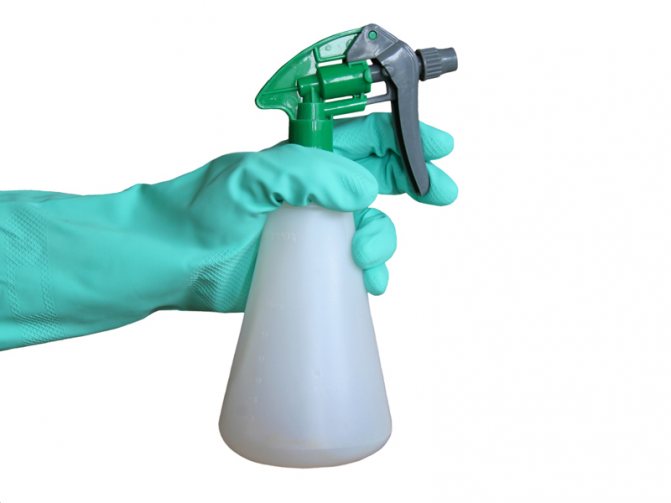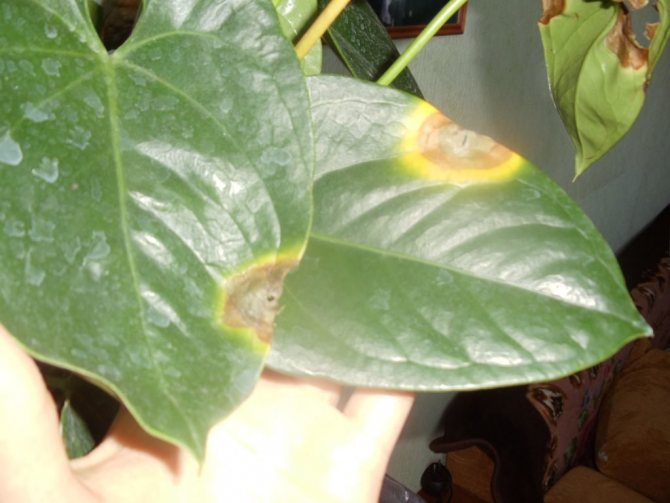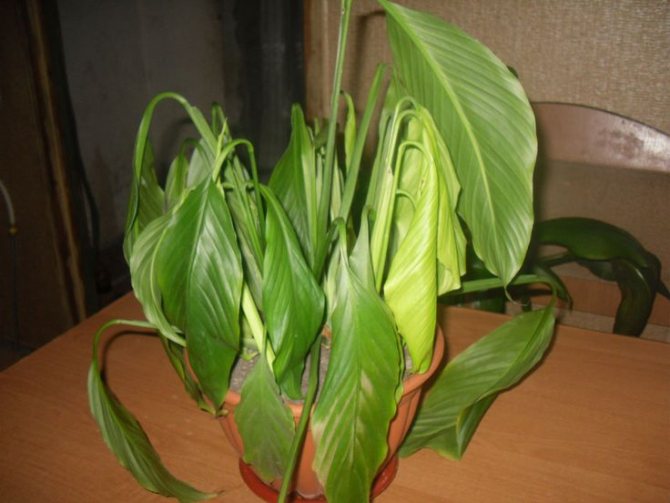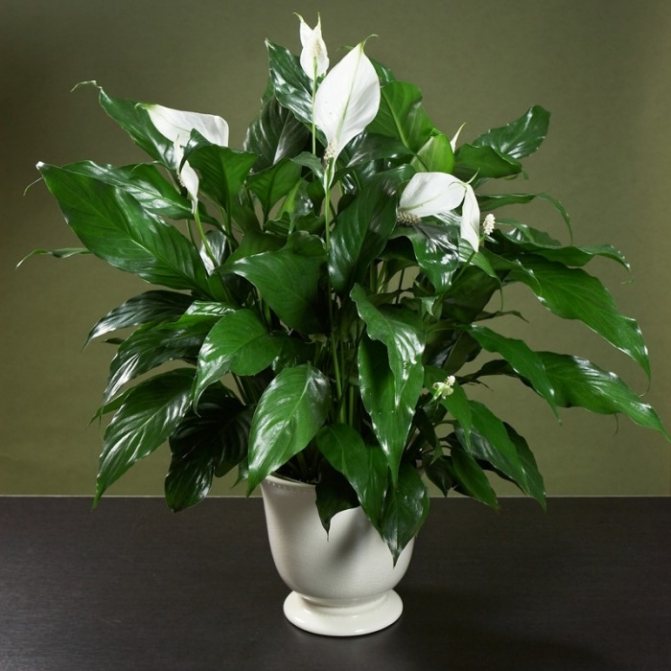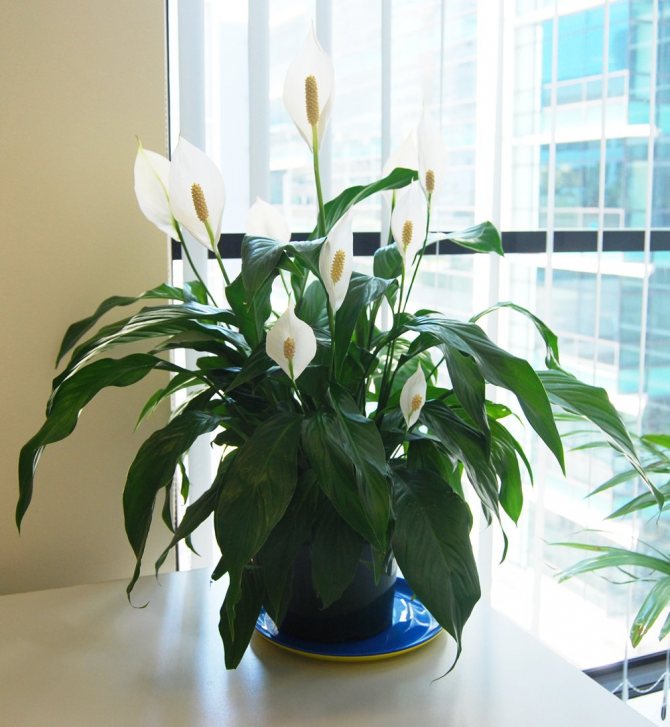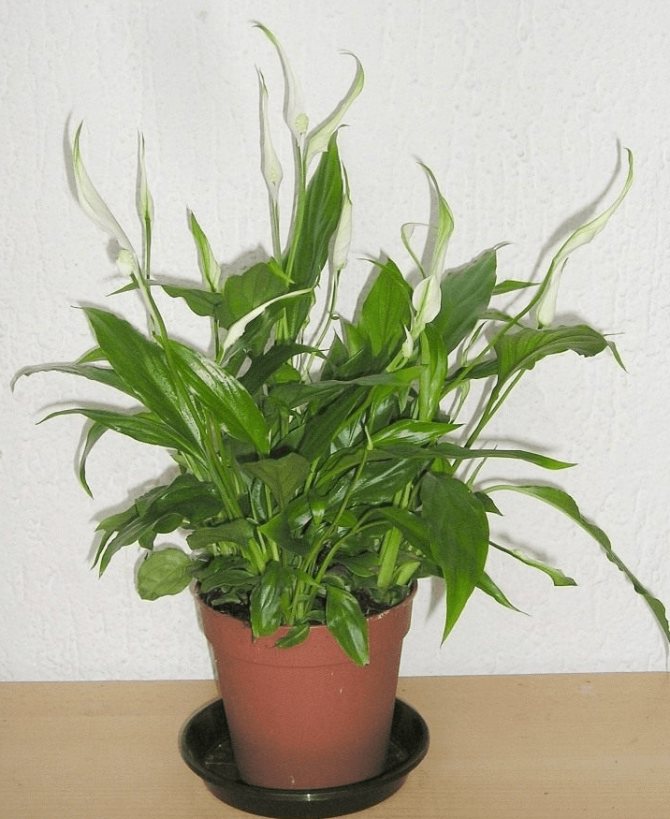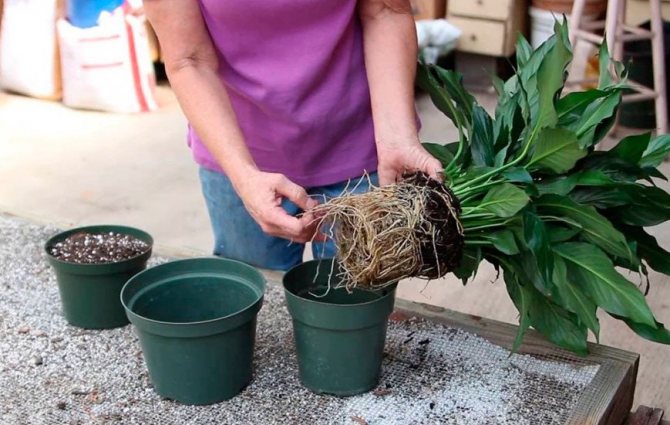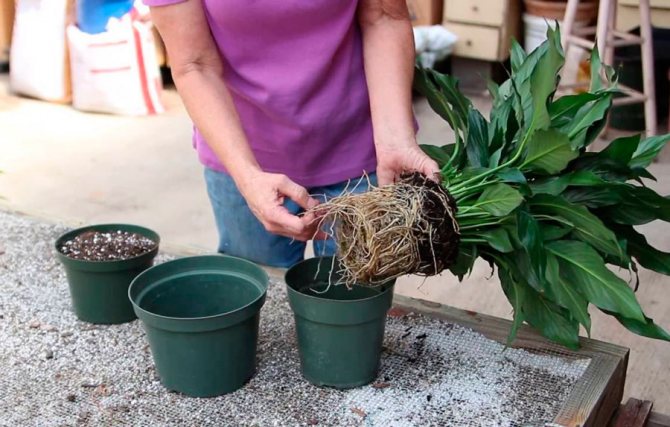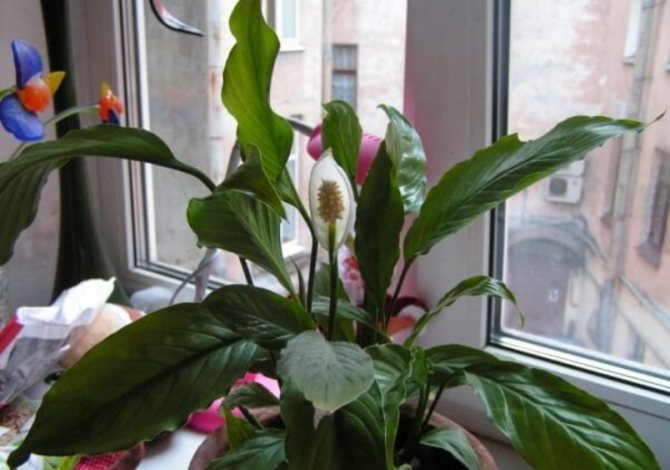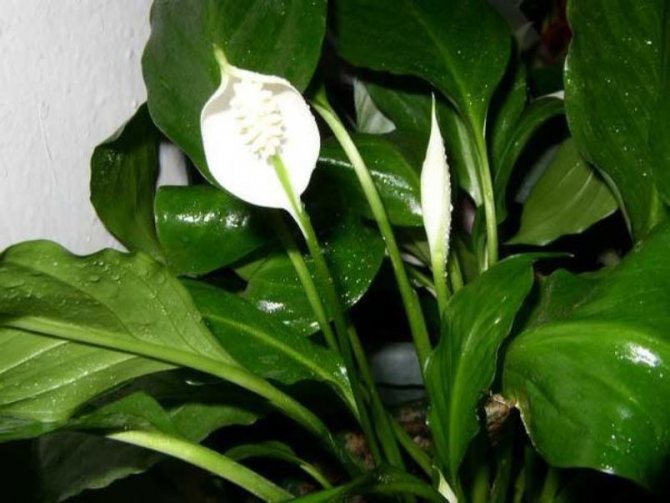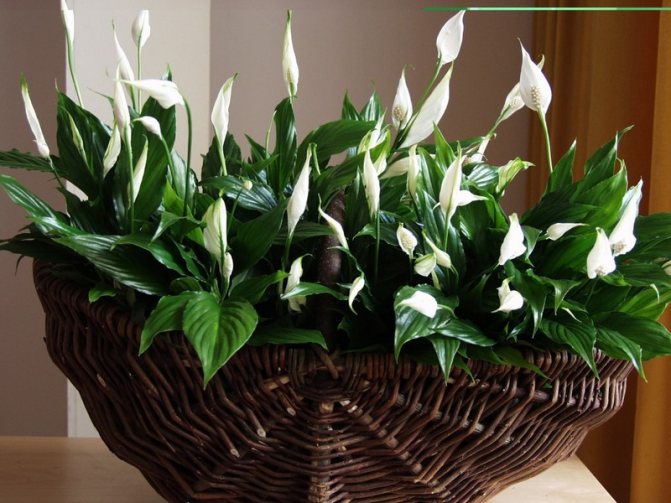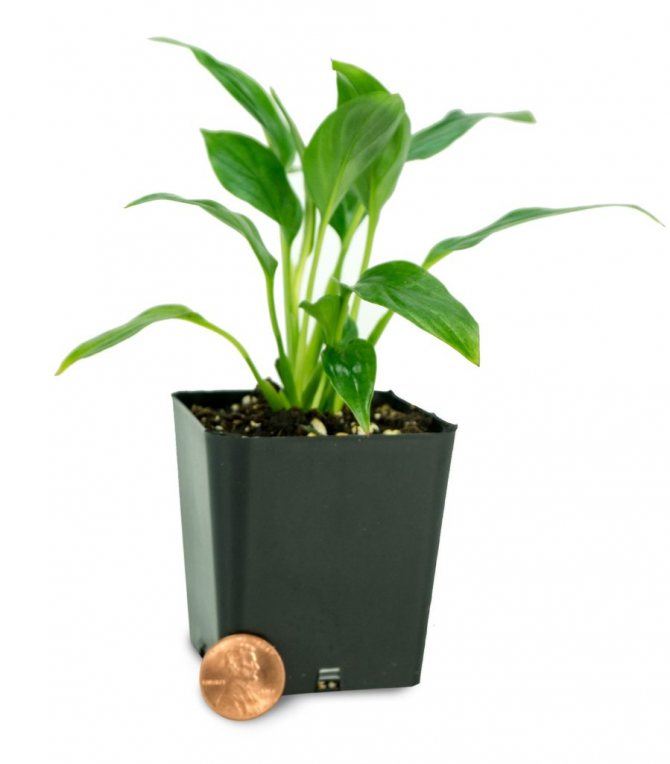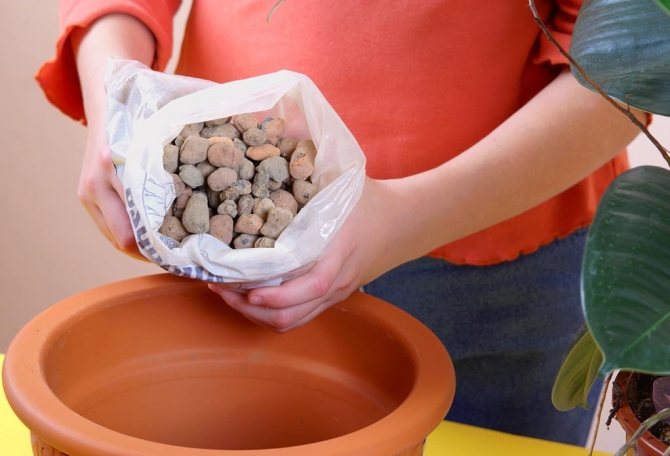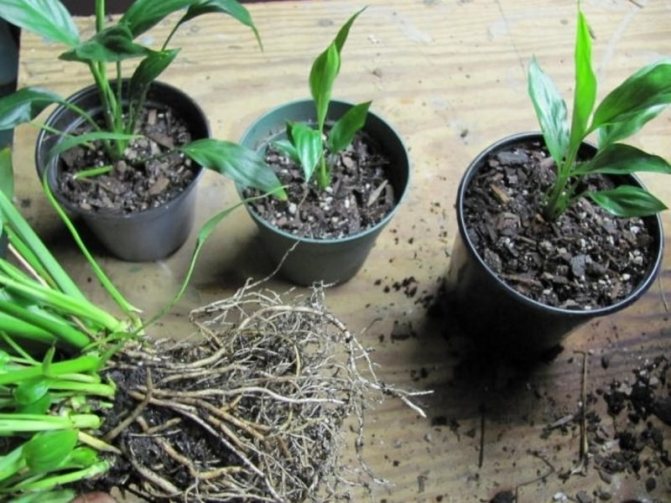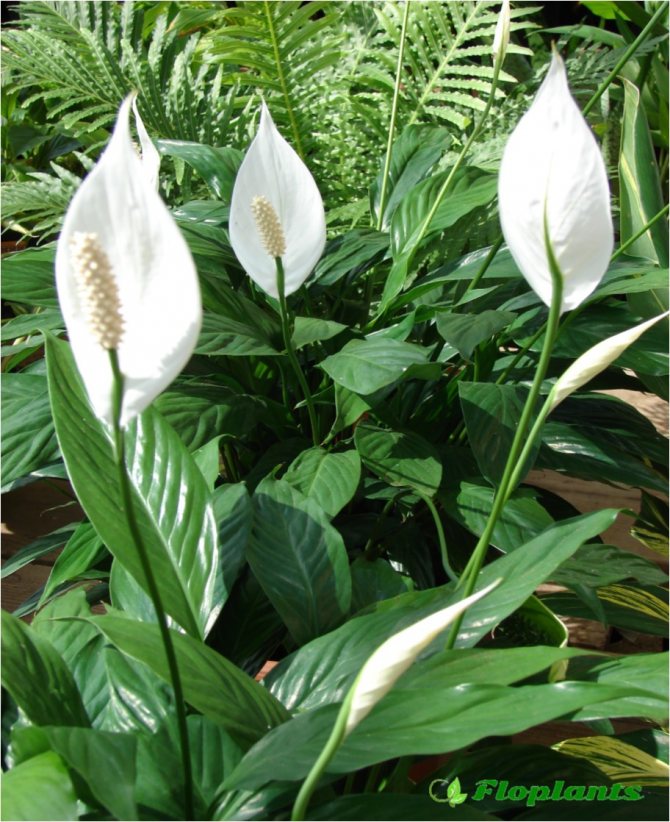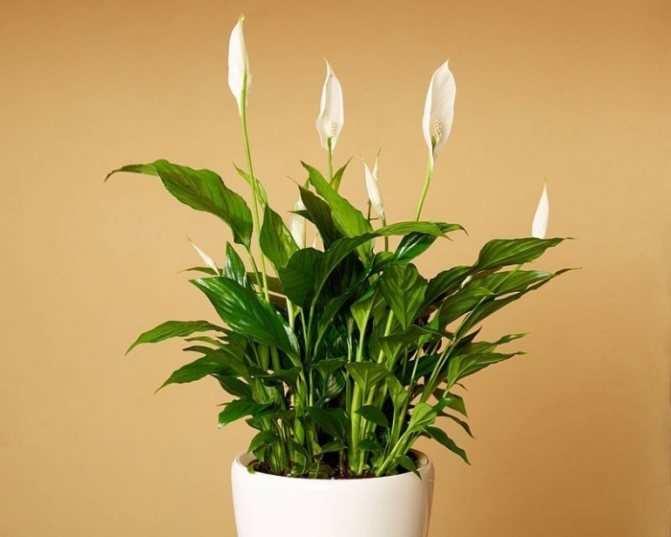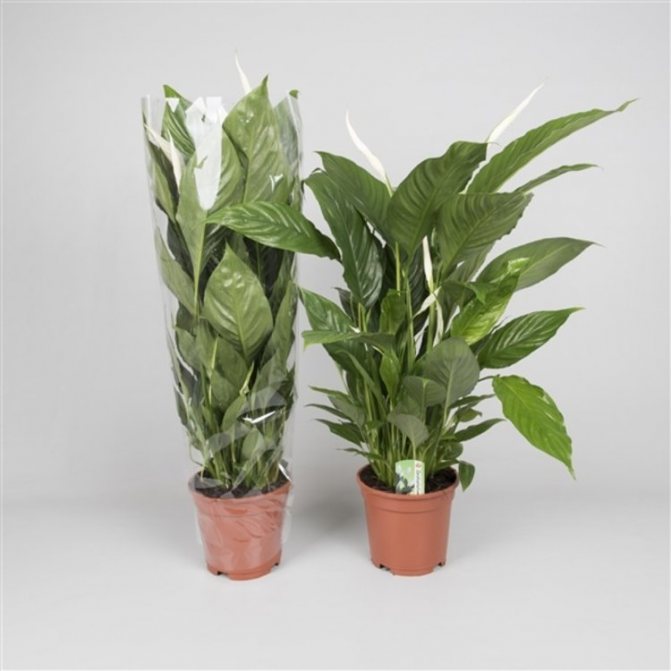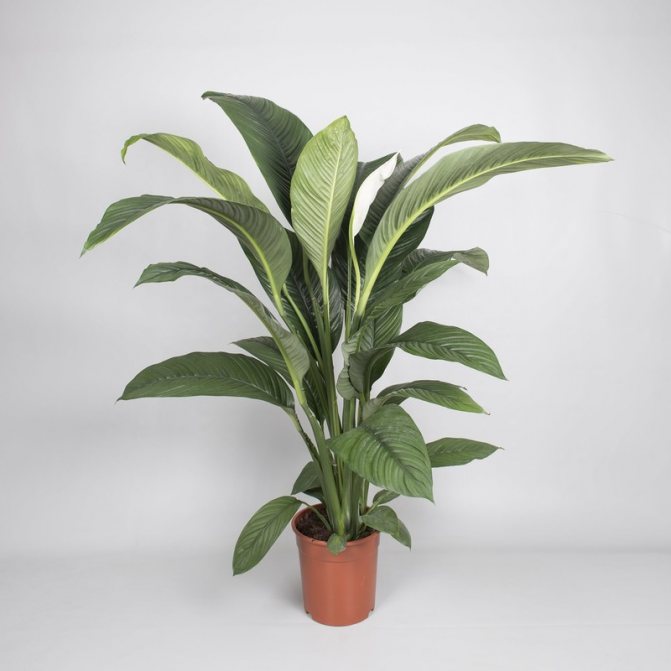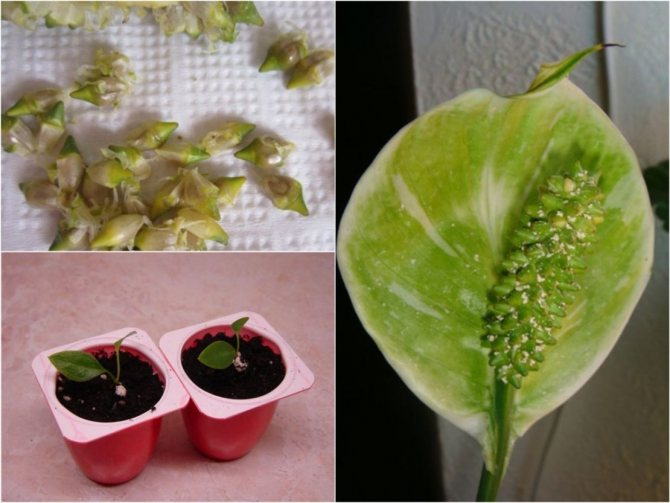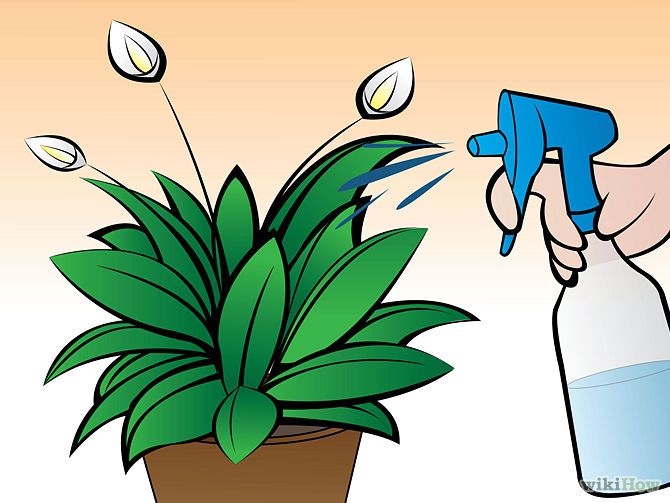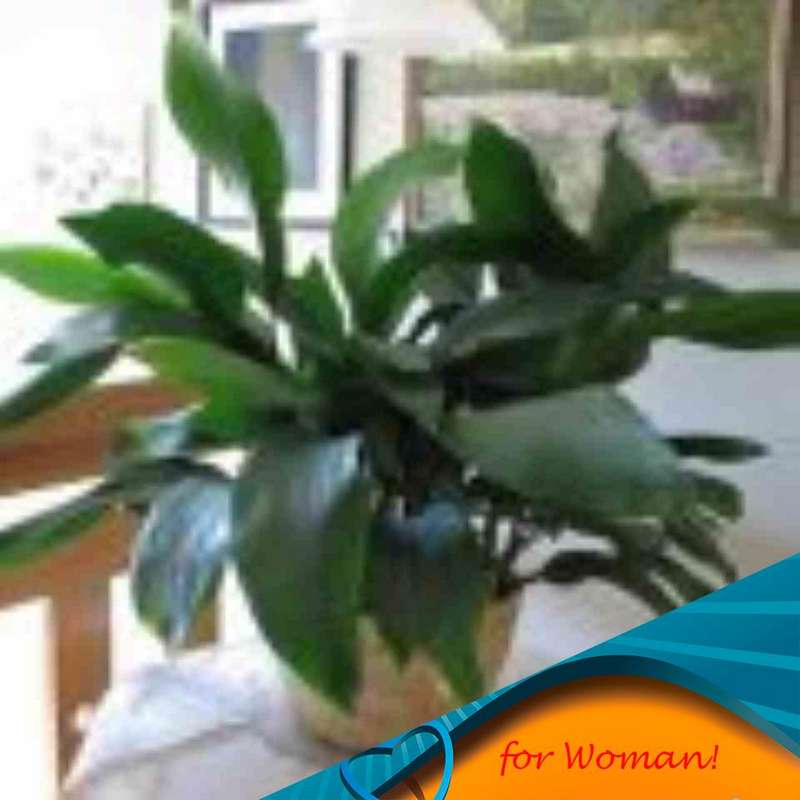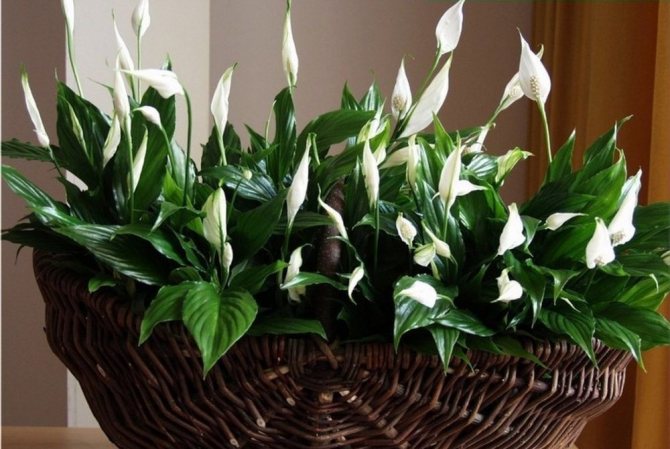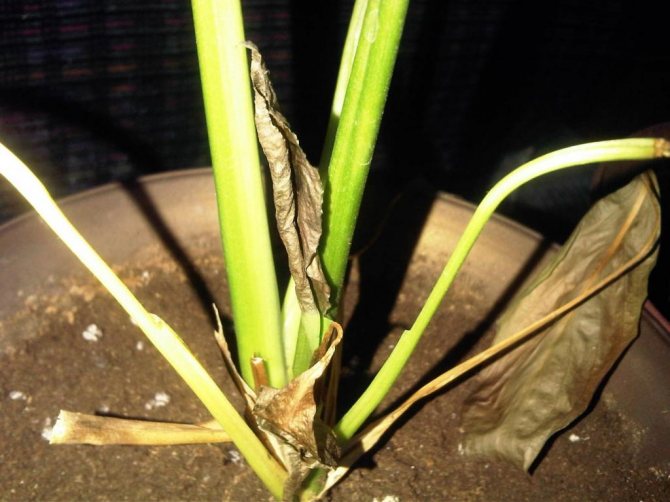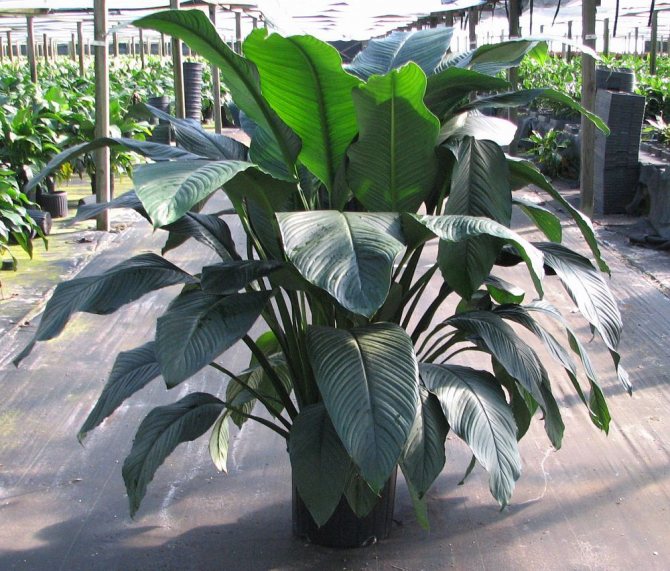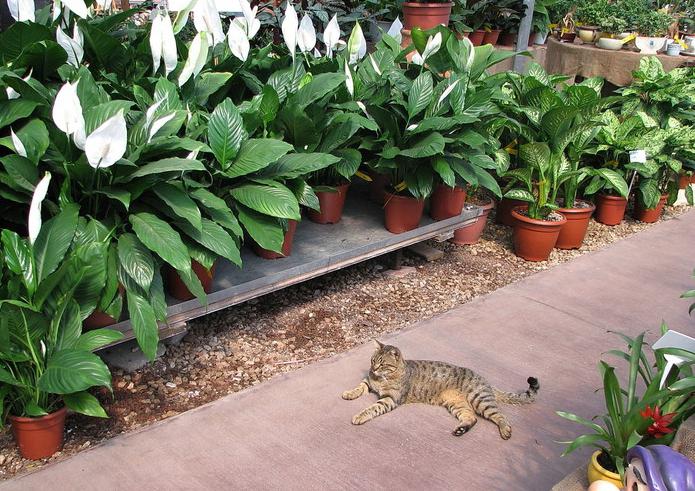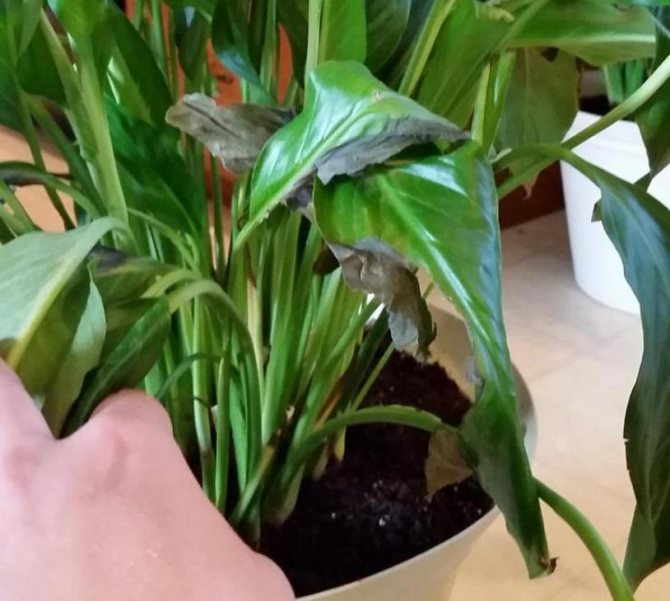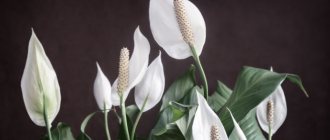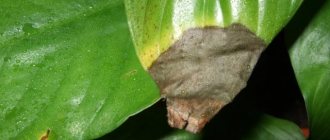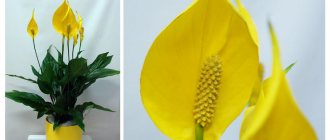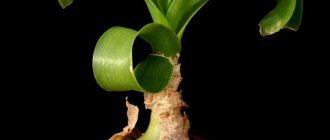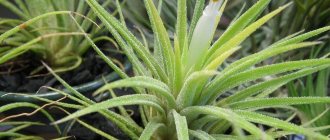Spathiphyllum or "woman's happiness" - a popular houseplant from the Aroid family.
Naturally, it grows in equatorial South America and the Philippines.
This flower got its name for the unusual shape of the bracts - the veil that envelops the ear-shaped inflorescence.
In addition to its decorative purpose, spathiphyllum has useful properties:
• Absorbs such harmful substances as carbon monoxide, formaldehyde, benzene, trichlorethylene, xylene from the room air;
• Moisturizes the air, saturates it with ions and phytoncides that inhibit the growth of molds.
Currently, about 50 species of spathiphyllum are known, of which the following are suitable for growing in room conditions:
• Abundantly flowering (Sp. Floribundum) - grows up to 40 cm in size. The ear has a creamy color, the cover is white at the beginning of flowering and turns green at the end. Blooms long and plentifully with proper care.
• Cannifolia (Sp.Cannifolium) it got its name for the similarity of its leaves with canna leaves. The flowers exude a delicate aroma.
• Wallis - a small plant up to 30 centimeters high, native to the Colombian rainforests. Leaves are dark green in color, oblong in shape. The cover is white, three times as long as the cob. Blooms profusely for a long time. Shade-tolerant enough and unpretentious in content. On the basis of this species, as a result of selective work, many varieties have been bred (for example, Picasso, Domino).
• Heliconiophilous - medium-sized species (grows up to 1 m in height). The dark green leaves have wavy edges and a glossy sheen. The oval cover is twice as long as the cob.
• Adorable (Sp.
blandum Schott) - the plant has elongated leaves with elongated tips. The greenish-white blanket is similar in shape to a flag. Hence the flower got its second name "flagolite". It blooms with a large number of flowers.
On the basis of the listed species, various varieties have been bred. Among them there are both giants (Sensation, Figaro, Pablo) and dwarfs (Mini). Hybrids are more hardy, bloom longer and more abundantly.
The following varieties of spathiphyllum are most popular in indoor floriculture:
• Mauna loa - a widely cultivated hybrid with long (more than 70 cm) wide leaves of a dark green color;
• Domino - differs in variegated color of leaves: on a green background, white stripes and strokes. The size of the plant is up to half a meter in height. The ear is white or beige. The white veil turns green towards the end of flowering. The variety was bred when breeding Wallis spathiphyllum, easy to grow at home;
• Chopin - a beautiful variety that has received worldwide recognition. Relatively short plant (up to 35 cm tall). Showering in a deep green color with depressed veins. Undemanding to care for. When flowering, it releases a pleasant aroma;
• Cait Is a Dutch variety derived from the Wallis species. Has variegated yellow-green leaves. The height is about 50-70 cm;
• Picasso - a variety with a bright color: white stripes on a dark green background, some leaves are completely white. It multiplies quickly and easily, is unpretentious in care;
• Sensation - “giant” variety of Dutch selection (grows up to one and a half meters in height).
Leaves are dark green ribbed 70-90 cm long and 30-40 cm wide. Shade-tolerant, fits well into the interior of office premises.
Plant features
Like other aroids, spathiphyllum is not fatal, but still poisonous. Its leaves contain calcium oxalate, so for some allergy sufferers, touching them can cause dermatitis. You should not even allow the cat, if you have one in your house, to chew on the plant. The death of the animal is unlikely, but sores on the oral mucous membranes, diarrhea and vomiting are unlikely to please you. On the other hand, spathiphyllum does not emit poisonous phytoncides into the air, so it does not threaten to inhale the poison. In this case, it is worth considering its useful properties. The plant perfectly cleans the air space in the house from harmful components. True, for this process to be effective, six to seven adult plants must live in a room of twenty square meters. However, this is not a problem - the reproduction of spathiphyllum is not difficult, even a novice florist can handle it.
Proper lighting is the key to success
So, you decided to have spathiphyllum home flowers in your house. Caring for them begins with a competent location within your apartment. Remember that they are rainforest plants where there is a lot of shade from the trees. So spathiphyllums will be just a godsend for those whose windows overlook a not too sunny side. Moreover, if you have a choice regarding illumination, you can achieve different colors and shapes of leaves: in diffused rays they will be lighter, brighter and wider, in a shady room they will be dense green and oblong. However, if the light is absolutely not enough, you will not wait for flowering, so after buying, observe how your spathiphyllum flower feels (care implies attentiveness). On the northern windowsills, the plant feels more comfortable, but on the southern ones it blooms more magnificently and longer; the main thing is to avoid direct rays that cause burns.
Choosing a windowsill
This plant is shade tolerant. Moreover, it just prefers dim, diffused lighting. In bright, direct light, the leaves of the spathiphyllum fade and begin to dry. So the ideal choice would be a north, usually empty window. True, if there is very little light (for example, just in this place a large branched tree grows), then the foliage becomes thick green, becomes smaller and stretches. Flowering is in question. And the reproduction of spathiphyllum will not be successful - new specimens simply will not take root. But this plant survives well under artificial lighting. Even fluorescent lamps are not required - ordinary, apartment ones are enough. This is used by phytodesigners when decorating offices and shops. In summer, it would be nice to take the pots outside - on the balcony or in the garden. But again, it is necessary to choose a shaded place so that the plants do not get burned and do not "feel sad" from the excess of the sun's rays.

Diseases and pests of spathiphyllum
Spathiphyllum does not bloom. If the pot is too large, then the spathiphyllum will not bloom. The flowering of a plant occurs after the pot is completely filled with roots.
Spathiphyllum leaves. Due to excess moisture in the soil, yellow-brown spots may appear on the leaves of the spathiphyllum. You need to water the plant only a day or two after the top layer of the substrate dries.
You cannot use liquid wax to add shine to the leaves of the plant.
Spathiphyllum leaves dry. When the air is very dry, the tips of the leaves dry out. In indoor conditions, this is almost inevitable.
The edges of the spathiphyllum leaves turn black and dry. Lack of phosphorus and nitrogen, excess moisture in the soil or low air humidity lead to drying and blackening of the edges of the leaves. It happens that the leaves that have not yet fully opened dry up.
Spathiphyllum pests. Most often, spathiphyllum is harmed by worms, spider mites and aphids.
- Houseplant groups (part 2)
Temperature regime
Spathiphyllum does not need to create special thermal conditions. Normal room temperatures are good enough for him. True, if the thermometer shows less than +18, the growth of the flower stops, and it will not bloom. Higher temperatures are also required during the reproduction of spathiphyllum: planted plants need 22-23 degrees for survival. Therefore, they are often covered with cut-off plastic bottles with holes, creating a mini greenhouse.
What you need to diligently protect spathiphyllum is from drafts. Even with a fan running nearby, the flower can get sick and die. When using the air conditioner, you should not turn on the mode below 20 degrees, and the pots with plants should be moved away from it.
It's time to change your place of residence!
I must say that this plant fills the space of the pot with its roots rather quickly. And the whole spathiphyllum suffers from this. The transplant and care afterwards are therefore a mandatory annual event. An alarming signal can be the roots crawling out from below through the holes for the drain of excess water. If you also remember that an overly voluminous pot slows down growth, worsens health and stops the flowering of spathiphyllum, you can come to the conclusion that it is better to spend a little time in the spring than initially planting in a too large container or delaying the transplant for a year.
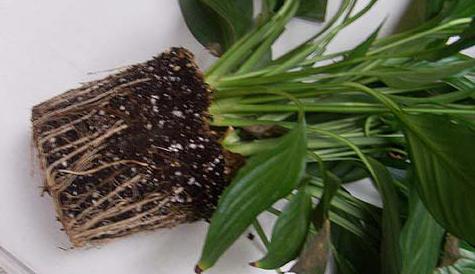

In the process, it is worthwhile to show maximum care - the flower tolerates damage to the roots with difficulty and then recovers for a long time. The soil can be "collected" independently from humus, charcoal and finely broken bricks. You can buy a substrate designed for aroids; at the same time, it will not be superfluous to refresh it with the same coal. Any selected soil for prevention is spilled with a strong and hot solution of potassium permanganate; the pot should be no more than 5 cm wider than the previous one. After moving, your spathiphyllum will become a little more capricious. Care after transplanting consists in regular, but not too abundant watering, keeping the seedling warm without drafts and systematic irrigation. If you want the flower to take root faster, build an impromptu greenhouse: cover with plastic or a plastic bottle (both with holes made).
How often to water
Spathiphyllum is a moisture-loving plant. The soil in his "house" should always be wet. There is no need to wait for the complete drying of the earthy coma. However, when overflowing, the likelihood of root decay is high. Therefore, if an hour after irrigation, there is still water in the pan, it must be drained. A sign of excess moisture is the appearance of dark spots on the leaves. Noticing them, it is necessary to revise the irrigation schedule. The lack of water is manifested by a sharp drooping of all leaves. Do not be afraid: literally in a couple of hours after receiving moisture, they will straighten again.
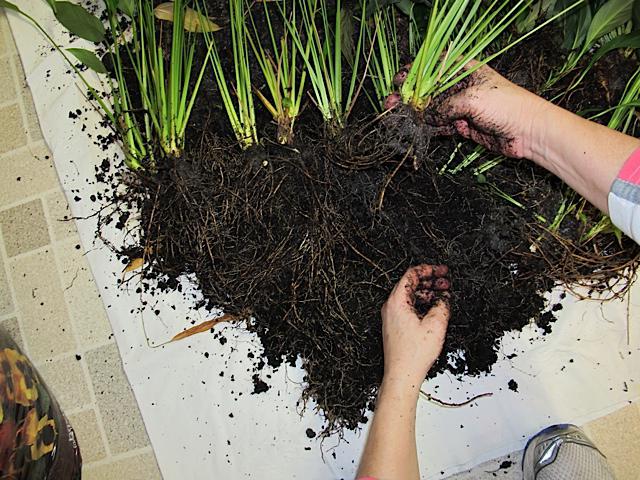

You need to be especially careful when watering the planted spathiphyllum - reproduction and transplants can injure the plant. Therefore, the earth is well shed before these procedures, and watering is resumed only after three to four days.
Spathiphyllum home care - feeding and watering
Watering
Spathiphyllum can be safely called a water lover - it loves to drink some water. He needs the most abundant watering during the period of active vegetation and flowering. The topsoil should dry out between waterings. However, it is important not to flood the plant and not dry out the earthen lump. Water for irrigation should be used separated (at least 12 hours) and warm, and preferably filtered.
Top dressing
From March to September, spathiphyllum is fed with a complex mineral fertilizer for decorative flowering plants. It is good to alternate with the introduction of organic fertilizers.All fertilizing is done only after abundant watering. Excess nutrition is manifested by brown spots on the leaves.
Humidity is important
Loves spathiphyllum and spraying - like all plants with a large leaf plate. In the heat, such manipulations must be done twice a day - in the morning, before the onset of the sun, and in the evening, when it dies down. If this is not possible (for example, in an office), the pot is placed in a pallet with damp moss, pebbles or expanded clay. However, even these measures do not eliminate the need to spray the flower in the summer at least every other day.
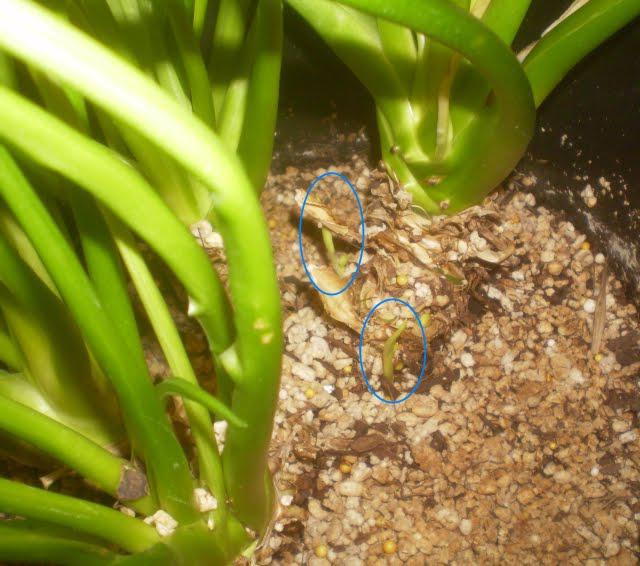

Botanical description
The Latin name Spathiphyllum Wallisii, popularly called the flower female happiness. There are about 40 varieties, differing in size, shape of leaf plates and inflorescences. A perennial plant can grow up to 1 m in height, some subspecies are indeterminate.
The leaves are 15-20 cm long, 5 cm wide, covered with well-discernible depressed lateral veins, the central one is pronounced. Decorativeness adds a slight waviness of the edges.
Dark green leaf blades are attached to long petioles emerging from the ground, the trunk is missing. Wallis spathiphyllum blooms in April - May for 1.5-2 months with an inflorescence in the form of a yellowish cob, covered with a white teardrop-shaped veil, which eventually becomes pale green. The rhizome is short and superficial.
The main varieties of Wallis spathiphyllum:
- Cladius;
- Chopin;
- Mozart;
- Macho;
- Numero Uno;
- Florin;
- Sweet Silvio.
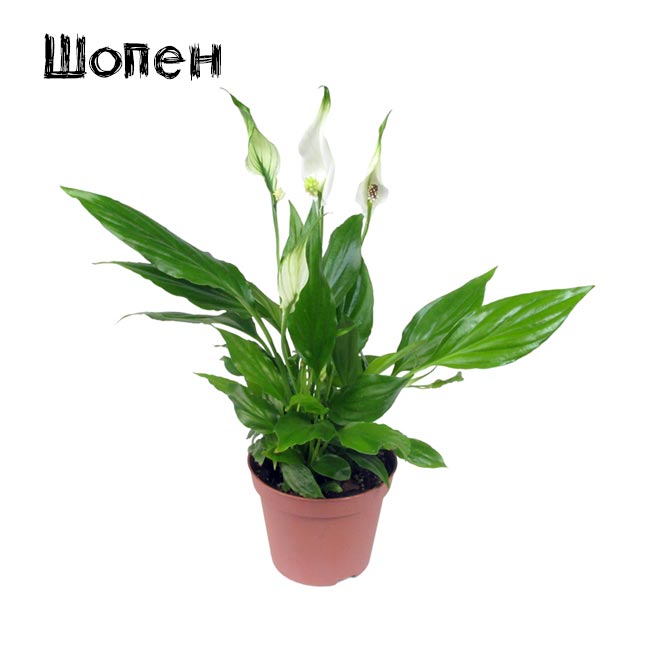

Transplants
Spathiphyllum needs moving to a new place of residence throughout its life. Young plants need to be replanted annually, adults who are more than five years old - only when the roots have filled the entire pot. You can determine the moment by the roots that have pushed through the drainage holes. A new pot is bought low and only slightly larger than the previous one: in such conditions, the spathiphyllum takes root faster and blooms more readily. Drainage is a must, and it is better to choose larger ones. If possible, you need to add sphagnum to the soil - the soil will not dry out too abruptly. An ideal substrate would be turf, sand, peat and leafy soil. The ratio is 1: 1: 2: 2. After transplanting, in the evening, the plant is sprayed with epin (two drops per glass of warm water). So it will take root faster and more painlessly. For the same purpose, watering is stopped, but spraying is required twice a day until watering is resumed.
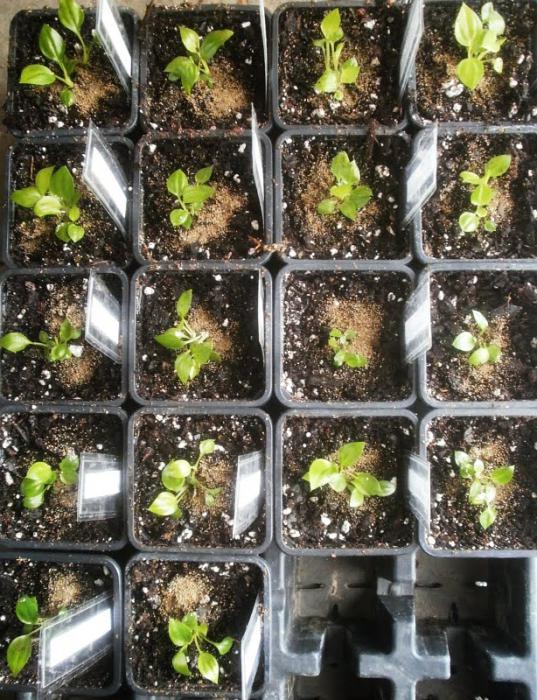

Where can one buy?
In specialized stores, you can buy the plant or its seeds. When buying seeds, be sure to check the expiration date - old seeds will not sprout.
A young plant can be bought in specialized retail outlets, greenhouses or online stores that not only sell but also deliver. The price of plants varies widely, depending on the age and type of plant, location and status of the store.
Types of spathiphyllum Chopin and Cupido can be bought for 300 rubles. The average price for Spathiphyllum Mozart fluctuates around 1,000 rubles, and the cost of the Claudius species reaches 6,000 rubles.
Proper care of the spathiphyllum will ensure good growth. And the unusual home flower will thank the hostess for her care - it will delight with its delicate flowers with a light aroma, bright green of lush leaves. And the plant will give harmony and peace of mind, help to fulfill all dreams and desires.
Leaf planting
Sooner or later, you will want to increase your plantation of these beautiful plants. First of all, we will warn against the mistakes of those who have not grown spathiphyllum before. Reproduction by a leaf is impossible for him. Unlike, for example, begonias, a spathiphyllum leaf immersed in water will simply rot without giving roots.The same will happen if it is immediately thrust into the ground, as is done with many succulents. Florists practice reproduction of spathiphyllum by cuttings or by dividing the rhizome. It is possible, of course, and the use of seeds, but it is complicated by many factors, which will be discussed below.
What if it doesn't bloom?
Not every grower has a purchased spathiphyllum in bloom. The reason for the lack of flowers is improper care, namely, low air temperature, insufficient humidity, and a deficiency of nutrients. It is necessary to ensure the optimal temperature and humidity, increase the dose of top dressing, and delicate beautiful flowers will definitely appear.
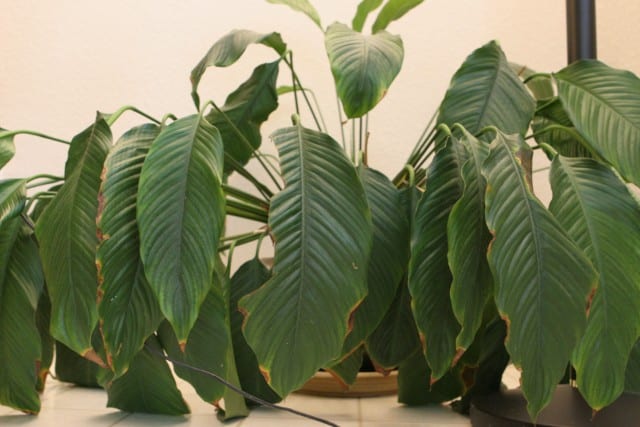

If you plant a flower in a pot that is too large, it will build up root and deciduous mass, but there will be no flowers.
Transplanting after buying into a pot that is too large can also delay the moment the flowers appear. Until the space of the pot is completely filled with roots, you should not expect flowering. You can correct the situation by transplanting the plant into a smaller pot.
Cuttings
Vegetative methods are applicable to almost any plant - some are larger, others are smaller. Spathiphyllum is no exception. Reproduction by dividing the bush is most popular due to the relative simplicity of the process. At the base of an adult plant, "babies" are formed - a small leaf rosette with spiked roots. In the spring, when it is time to transplant, they are carefully separated from the mother plant. The main thing in this process is to untangle the roots, trying not to break them off. The cuttings are rooted in wet sand or perlite. Reproduction of spathiphyllum will occur without trouble if each new bush is covered with a transparent cap, preferably with holes. If they are absent and it is impossible to do them, you will have to air the plantings two or three times a day. When the root system grows and gets stronger, the planted plants move to the substrate prepared in the already described way.
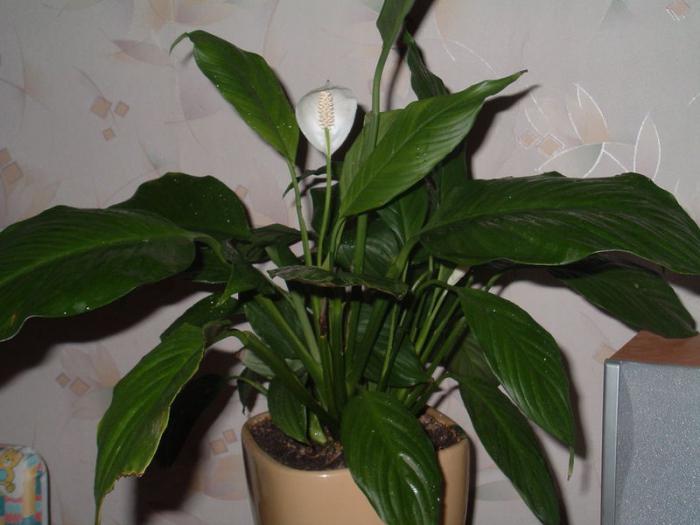

How to propagate spathiphyllum by dividing a bush?
I propagate spathiphyllum by dividing the bush. It is convenient to do this when transplanting. It is better to divide the bush at a temperature of + 20-21 ° C.
- I divide the bush very carefully, without damaging the delenki and roots, so that the plant takes root well. I remove the withered leaves immediately.
- If there are no roots when dividing, I put it in water for rooting for 2-3 weeks. When the roots appear 2-3 cm long, I plant them in the ground.
- If I do not want my plant to grow, I can leave one point from the growth and the rhizome.
I take into account that each new rhizome has several leaves, at least 2-3. I plant the delenka in a pot with a diameter of 15 cm, but no more. I pre-fall asleep with a substrate (how to prepare a mixture, see above).
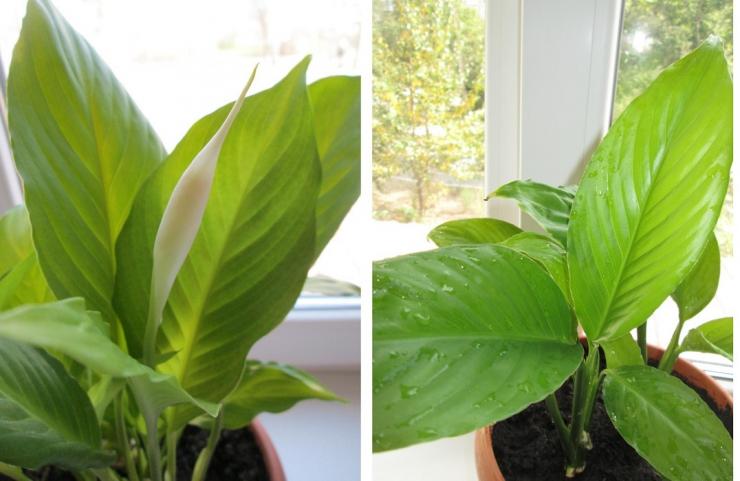

Photo: a healthy plant has juicy green elastic leaves
Rhizome division
You can also plant spathiphyllum in another way. Reproduction by root divisions, on the one hand, gives almost one hundred percent survival rate. On the other hand, you need to be able to do this so as not to ruin the mother plant. So only experienced florists resort to it. Such an operation is also performed in the spring, during transplant manipulations, so as not to disturb the plant once again. The rhizome is divided with a sharp knife, the cuts are sprinkled with crushed charcoal. Not activated in any way! The rest of the steps are the same as for grafting.
Heat is the key to health
When choosing a temperature regime, you should not, again, forget where the indoor plants spathiphyllum come from. Care in this regard is to keep the flowers from freezing in winter. It is unlikely, of course, that you live in very wild conditions, but if there is an unheated (for example, uninhabited, guest) room in the house, the spathiphyllum must be removed from there. Even plus 10 is a lethal temperature for him; with it, the flowers rot, and it is almost impossible to "pump out" them after that (to say nothing of lower values!).The minimum at which plants are viable and do not get sick is plus 16; if your heating is turned off in winter, warm the room at least with a fan heater. And exclude the possibility of drafts: they are destructive for these plants.
Seed troubles
There is another way, very unreliable, to get a new spathiphyllum. Reproduction at home using seed is theoretically possible, but unlikely to be successful. Firstly, to obtain them, artificial pollination will be required, which does not always give the planned results. Secondly, the germination rate of the seeds of this flower is very low. Moreover, the seeds are not stable: even after a day, half of them are guaranteed not to sprout. Thirdly, after sowing in sandy-peat soil, the container is covered with glass, and your task is to simultaneously maintain its moisture content and prevent the seed from suffocating. Therefore, in general, the method remains purely theoretical - gardeners propagate spathiphyllum vegetatively.
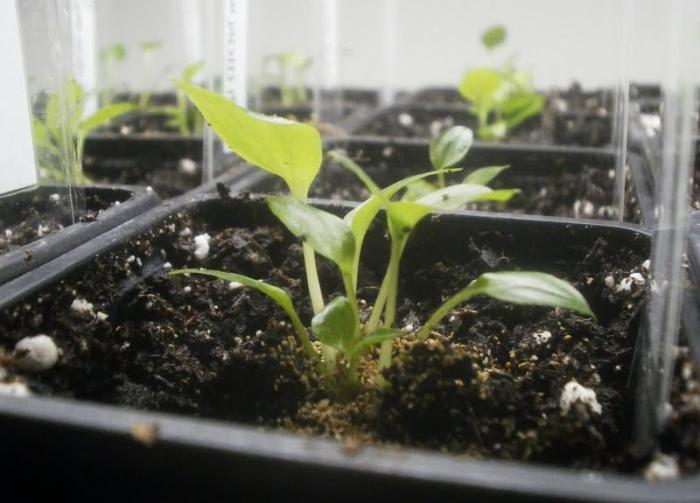

Growing problems
For those who grow spathiphyllum, home care does not present any particular difficulties. However, spathiphyllum is susceptible to disease, it can be affected by insect pests. Below are the most common problems that growers face when growing, and how to solve them.
Leaves turn yellow and wither
This situation is observed when the soil dries up in a pot. If spathiphyllum has dropped yellowed leaves, it needs to be watered more often to completely soak the ground. At the same time, the amount of water should be increased gradually - a sharp transition from drought to abundant watering should not be allowed.
The tips of the leaves dry
The most common causes of leaf dryness are:
- planting in unsuitable soil;
- direct sunlight (causes leaf burns);
- a sharp transition from drought to abundant watering;
- watering with too cold water;
- low air humidity (especially in summer in the heat, or in winter when heating devices are working).
Adequate moisture can be ensured by:
- regular spraying;
- placing a tray with sand or expanded clay, moistened with water, near the flowerpot;
- special devices - humidifiers.
Leaves turn black
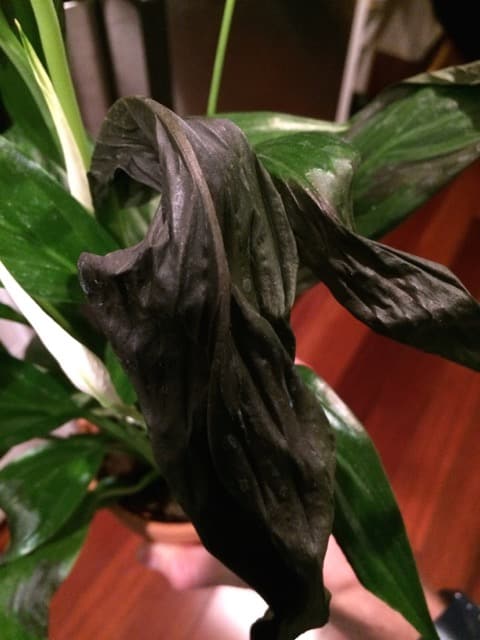

Black leaves of spathiphyllum can signal excess moisture that has caused root rot.
The reasons:
- frequent or abundant spraying;
- low air temperature;
- lack or excess of nutrients (more often a deficiency of phosphorus-nitrogen fertilizers);
- excess moisture.
With an excess of moisture, the leaf plates turn black, and the root system rots and dies off. If the leaves turn black, the flower must be removed from the pot. After examining the root system, remove the rotten roots, transplant the flower into another soil.
If the leaves on spathiphyllum have turned black due to a deficiency of nutrients, you need to feed it with complex nitrogen-containing fertilizers.
Spider mite
A dangerous pest appears on the underside of the leaf plates, processing them with cobwebs. Soon, the leaves begin to dry. The diseased plant is sprayed with soapy water, after having cleaned the leaves from the cobwebs with a damp sponge.
If the solution does not help, you can use insecticides, ground sulfur. Some growers in the fight against spider mites use the following recipe: 100 g of onion husks are poured with 5 liters of water, insisted for at least 5 days. The resulting solution is sprayed onto the plant.
Aphid
Black, green or gray aphids settle on the bottom of the leaf plate, multiplying very quickly. The pest feeds on plant juice, as a result of which the leaves begin to dry, curl. To destroy aphids, the plant is treated with a solution of nicotine sulfate (1 g of the product is diluted in 1 liter of water) or a soap solution. If necessary, the processing is repeated.
Shield
When the scabbard attacks, the leaf plates are covered with dark spots.The plant is treated with soapy water with the addition of tobacco and kerosene. Then the flower is washed with clean soapy water and insecticides.
Mealybug
The mealybug appears between the leaves due to excessive dampness. If there are not many insects, they can be easily removed with a cloth soaked in alcohol. In case of severe infection, the plant must be treated with actellic, insecticides or infusion of citrus peel.
During processing, you need to ensure that the solution does not get into the soil, otherwise not only pests, but also the flower itself, will die. After treatment, the plant is washed, while the ground is also covered with a film.
Bloom
The main thing that attracts lovers of indoor plants in spathiphyllum is long, up to two months, flowering. An additional bait is the fact that most varieties produce "cobs" quite willingly. However, it happens that, despite the care and proper care, the plant is capricious. There are several ways to nudge him in the right direction.
- Rearrange the pot. Most often, the refusal to bloom is caused by an unfavorable light or thermal regime. You can try moving the plant to a brighter location. At first, in order for it to get used to it, you need to either shade it or move it to a less illuminated place. After adaptation, it will be possible to give the spathiphyllum more light. Very often, almost immediately, he throws out the buds.
- High humidity often stimulates flowering. Either make more frequent sprays, turn on a humidifier, or simply place a container of water next to it.
- If such simple actions did not give a result, transfer the spathiphyllum (temporarily!) To water starvation. First, water it less often for a couple of weeks, and then leave it completely without water for a week. To avoid damaging the flower, spray it more often. After maintaining the indicated time, move the pot closer to the light, return to normal irrigation regime and feed the spathiphyllum with fertilizers for flowering plants. Within a month, it will bloom.
Well, in order for the flowering to be longer, the faded "ears" should be cut off in time. Then they will not hinder the development of new ones.
Try to bring spathiphyllum to your window garden. Reproduction, easy and almost always successful, will allow you to quickly decorate your home with this beautiful plant with glossy leaves and delicate white flowers.
Spathiphyllum is an evergreen houseplant. In another way it is called "female happiness." According to legend, a flower is able to establish family life, and to find a second half for unmarried women. Due to its unpretentious care and beneficial properties, the plant is very popular for growing at home. For abundant flowering of spathiphyllum, you must adhere to the recommendations to create optimal conditions.
Description and features
Blooming spathiphyllum in the wild
In translation from the Greek language "spati" means a veil, and "phillum" means a leaf. The flower belongs to the Aroid family. In nature, it grows in tropical forests with high humidity. These include Colombia, Venezuela and the Philippine Islands.
A feature of the plant is the absence of stems. Glossy oblong leaves grow directly from the ground. They show the middle and lateral veins. Height reaches 30 cm, but there are other varieties. Inflorescences of an interesting shape. On the long arrow there are small cream-colored flowers. They are protected on one side by a large white hood, which turns green over time. This form is not accidental. In nature, the veil serves to attract insects and at the same time protects the flower.
The plant begins to bloom from six months of age. Depending on conditions, inflorescences appear 1-2 times a year. With specialized home care for spathiphyllum, there will be regular flowering.
Main types
Wallis' spathiphyllum differs from its congeners in its large size
There are over 40 varieties of the plant. For the home, it is recommended to choose the most unpretentious care.
Popular varieties:
- Adorable view differs in oblong leaves and a hood with a pointed end. The cover is slightly bent away from the inflorescence.
- Profusely flowering variety able to delight with flowers throughout the year. The leaves are oval, and the inflorescences are medium in size. The plant reaches a height of 50 cm.
- Wallis Spathiphyllum reaches up to 30 cm in height. Large dark green leaves create a beautiful bush shape. Abundant flowering.
- Variety Sensation bred by breeders to decorate garden plots. The hybrid reaches up to 1.5 m in height. It is distinguished by its large leaves and flowers.
- Picasso differs in white streaks on the leaf. Special care for spathiphyllum is not required. Able to multiply rapidly.
- Dominoes is a neat species with colorful leaves. Flowers with pointed ends are also highly decorative. It can bloom for a long time.
- Chopin is a small bush. Clear streaks are visible on the leaves. Can grow in the shade and on the sunny side.
- Heliconium species characterized by wavy edges. The root system is developed and can go 90 cm into the ground. The inflorescence reaches up to 10 cm and gradually darkens over time.
- Spoon-shaped variety got its name from the type of flower. Stems are found up to 1 m in height. Large dark green leaves.
Beneficial features
The plant is famous for its positive properties. Spathiphyllum is able to cleanse the air from harmful impurities. The flower neutralizes acetone, carbon monoxide, formaldehyde and other harmful impurities... Several hours are enough for cleansing.
Also, due to the large leaf area, the plant is able to emit ozone, which helps to improve the functioning of the human respiratory system.
The plant helps to humidify the air, which in the process is saturated with phytoncides. Mold does not form under these conditions. In terms of decorative function, the spathiphyllum is able to decorate any interior, even in a room with poor lighting.
It is also believed that the plant carries positive energy into the home. It creates a favorable background for building relationships in the family and solving existing problems. For lonely people, the flower will attract a soul mate to the house.
It is also believed that young couples soon become parents. Therefore, the name "female happiness" is fully justified. So that the plant does not harm, you should adhere to safety precautions and recommendations for caring for spathiphyllum at home.
Care rules
It is quite simple to organize all the conditions for the correct growth and development of a plant. The flower is unpretentious in care, but flowering appears only if the requirements for soil, temperature and humidity are met.
Key recommendations:
Lighting should be diffused. It is advisable to cover the glass with a film or a white sheet. Bright sunlight can damage the leaves and the plant will die. In the complete absence of light, flowering stops, and the leaves acquire a rich color. Therefore, spathiphyllum grows better on a window on the north side in the absence of drafts.
An important parameter when caring for spathiphyllum at home is the ambient temperature. The optimal value in summer and spring is 23-24 ° C.... When the temperature drops to 16 ° C, a slowdown in growth and development is observed. Frosts are unacceptable, because the plant will die.
Spraying a flower
The air must be well humidified. It is required to spray the leaves at least 2 times a day. For additional humidification, a container of water can be placed next to the pot. When spraying with a spray bottle, you need to be careful so that water does not get on the inflorescences. You can harm the plant.
Water the flower regularly
During the period of active growth, it is important to ensure abundant watering. Room temperature water will do. It is advisable to let it settle in an open container during the day in order to rid the liquid of heavy metals. In hot weather, you need to water several times a day. It is important that the water does not get stagnant at the bottom of the pot. Root decay and plant death can be provoked. In cold weather, watering twice a week is enough.
Preparing the soil for spathiphyllum
There should be loose and fertile soil. You can purchase a ready-made mixture or mix it yourself. This will require peat, sand and humus. You can create an expanded clay air cushion.
It is recommended to transplant to a new location every two years. During the adaptation period, it is necessary to provide careful care of the plant. It must be remembered that there will be no flowering after transplantation.
Conditions for flowering
At first, a young plant will grow foliage and you should not wait for the appearance of inflorescences. If an adult plant does not bloom for a long time, the conditions of care at home should be adjusted.
Key recommendations:
- The root system should be cramped. You need to find the optimal pot size. Stressful situations for plants should be avoided, but at the same time, there should be no room for roots.
- The wrong balance of trace elements in the soil can lead to a lack of flowering. An overabundance of nutrients will create conditions for foliage to grow, and an insufficient amount will lead to plant disease.
- As for a tropical plant, you need to provide high humidity and abundant watering. The flower will die during drought and lack of moisture. Spraying is carried out only with warm water.
- If flowering does not appear, then you need to reduce the ambient temperature to 15 ° C. In the spring and autumn period, it is enough to take out the pot with the plant on the balcony or outside the window for two weeks. It is important that the place is free of drafts.
Transferring to a new pot
Spathiphyllum transplant process
It is required to observe the transplant regimen. Young plants need to be replanted once a year.
it is enough to transfer adult flowers to a new place every 2-3 years.
The pot is important to choose the optimal size. Containers a few centimeters larger will do. At the bottom there should be a drainage of stones or expanded clay. It will avoid stagnant moisture and possible root rot.
The transplant in the usual way is carried out with an earthen lump. If the plant is damaged, pruning and soil replacement is required. It is important to carry out the procedure carefully so as not to damage the root system.
Sequencing:
- preparation of the pot and new soil;
- removing the earthen clod from the container;
- pruning damaged leaves and roots;
- neat transplant to a new place;
- abundant watering and spraying.
After transplanting, you need to create greenhouse conditions. For this, the ground part of the plant is covered with a film or plastic bag. Ventilation is required periodically. If necessary, fertilizing is carried out with complex fertilizer. Organic matter can be used. If dark spots appear on the leaves, then the amount of trace elements should be reduced.
Breeding features
Reproduction by dividing the bush
There are several ways to propagate plants. The planting material is obtained from an adult plant. Subject to the requirements of transplantation and care of the spathiphyllum, there will be no problems during transplantation.
Breeding methods:
Spathiphyllum seeds
It is quite difficult to grow an adult plant using seeds. This will take time and patience. Seeds should be planted immediately after harvest as they they are not stored for a long time. You should take a shallow container with nutrient soil. After disembarkation, they provide greenhouse conditions. It is required to ventilate periodically so that mold does not form.The seedling quality depends on the planting material. Provided that purchased seeds, it is important to monitor the expiration date.
Reproduction method by cuttings. They separate from the mature plant. If a root system is present, then it can be planted immediately. In its absence, the roots must be soaked in a solution of activated carbon. For better rooting, you can create high humidity and water the plant with the substrate. The flower will grow stronger in a few months.
Reproduction by dividing the bush is the easiest way. For this, the rosettes of the mature flower are separated from the ground. Transplanting is important for the proper development of the plant, because young shoots absorb all the nutrients from the soil. An adult plant from this stops developing and begins to hurt. It is important to divide it in the spring, before the start of the growing season. The formed rosette is considered to be at least 3 sheets.
Before propagating by cuttings or dividing, it is necessary to carefully examine the sprouts. Dried roots and leaves must be removed. In a new place, plants need to create optimal conditions.
Pests
The flower at home is attacked by insects. At the first sign, action is required.
The main pests:
Scabbard on flower leaves
Aphid concentrates on the ground surface. The ideal conditions for its emergence are excessive or insufficient watering. Signs are white bloom and clots on the surface. The leaves of the plant begin to fade and the flower dies.
It is important to treat the soil several times a week with an antibacterial solution until complete recovery. A weak solution of manganese is suitable for this. A simple transplant will not help. aphids will begin to multiply in new soil.
Spider mite feeds on juice. The plant is completely covered with a white bloom. To combat, you should use special spray solutions. A solution of olive oil, garlic and water will also work. During processing, the room must be thoroughly ventilated. To avoid contamination of other plants, it is important to carry out the treatment immediately at the first sign.
Shield rarely appears at home. Juveniles can only be seen in dark spots on the leaves. Adult insects can be seen with the naked eye. In order to get rid of pests, the sheets must be wiped with diluted kerosene. It is required to be careful during the process. In case of allergies, it can be replaced with a soap solution.
Mealybug it affects the leaves of the plant quite rarely. Insects feed on sap and lead to the complete death of the flower. In order to get rid of pests, peels from citrus plants are used. The insect does not tolerate the smell of essential oils. Can also be treated with chemicals.
Major diseases
"Sick" leaf of spathiphyllum
There are a number of diseases that spathiphyllum is susceptible to. The plant, with proper treatment, can be saved.
Flower diseases:
Chlorosis of leaves occurs as a result of an excess amount of fertilizer in the soil. It is required to normalize the composition of the soil. Gommoz infects the plant with dangerous viruses and bacteria. Dark areas should be removed and adjacent leaves should be wiped with soapy water. Root rot occurs as a result of waterlogging of the soil. It is necessary to dry the soil and thin out the bark system. When fungal diseases an effective way would be to treat the flower with sulfur powder.
As a preventive measure, the plant should be inspected regularly. If suspicious symptoms are found, treatment should be started. You can temporarily move the flower to another room so that neighboring indoor plants do not get sick. Also, for preventive purposes, you can treat with chemicals to avoid the appearance of diseases.
Growing problems
Diseases are not always the reasons for the poor health of the plant.With improper care, "female happiness" begins to fade.
Possible problems:
Poor growth is due to excessive soil moisture. Also, bright or insufficient lighting can be the cause. The problem is usually eliminated by changing the location of the pot on the windowsill.
Leaves dry or dark spots appear. They can cause sunburn. In such cases, the pot is moved to a shaded area. Black inflorescences indicate the onset of rotting due to waterlogging of the soil. To do this, let the soil dry out. You may need a transplant.
Yellow leaves indicate that the flower is not watered enough. Water should not stand at the base of the roots, but the soil should not be allowed to dry out either. The plant must be provided with a tropical climate.
Deformation of inflorescences or leaves appears as a result of the lack of sunlight. Provide diffused lighting on the north side of the window.
In the absence of flowering, the optimal amount of minerals should be added to the soil. Top dressing is added twice a year or as needed. You can use ready-made fertilizers or mix them yourself.
Useful Tips
Basic rules to help avoid problems with growing:
Transplant pots should be well disinfected. It is required to choose fresh, tested soil every time. So that there are no insect larvae in it. It is required to select only trusted manufacturers. It is important to use a spray bottle with small holes. In this case, steam will form above the flower. Water droplets on the stems are very dangerous because they lead to decay and death. In winter, in order not to overcool the roots, you can place the pot on the platform. A stand made of wood or foam will do. If dried roots are found in the process of transplanting a flower, then they should be removed immediately. You can use scissors or pruning shears for this. It is important not to hurt healthy areas. With careful care, the root system will recover quickly. Citric acid is used to soften the water for irrigation. You only need to add 2-3 mg per liter of water. It is required to observe proportions so as not to harm. Conclusion
If you know how to care for spathiphyllum, then the plant will delight with its regular flowering. Basic recommendations will help you avoid growing problems.
In case of illness, you need to take action in time. Often a transplant is required to save the plant. In general, "female happiness" is unpretentious in care and can grow in any home.
How to get several from one
Suppose you have already figured out the place where the spathiphyllum will be comfortable, decided on its content and arranged a timely transplant. You like the flower, caring for it does not cause any special problems, it fits perfectly into the interior, and now I want more such plants. Cutting in the case of spathiphyllum will not work - you will have to learn how to divide the rhizome. The best time for this is spring, when the plant is usually transplanted. This is done as follows. The flower is carefully removed from the pot, slightly shaken off the ground (just so that the soil does not interfere, you should not completely clean the roots). Then the rhizome with a sharp knife and is extremely carefully separated. In each segment, 2-3 leaves should depart from the roots, no less. The resulting delenki are deposited in low and narrow pots. The easiest way is to fill them with ready-made soil for aroids; if you want to be confident in the soil - make it yourself from leafy and coniferous soil in combination with peat and sand (ratio 2: 2: 2: 2: 1) and a little charcoal.
Major diseases
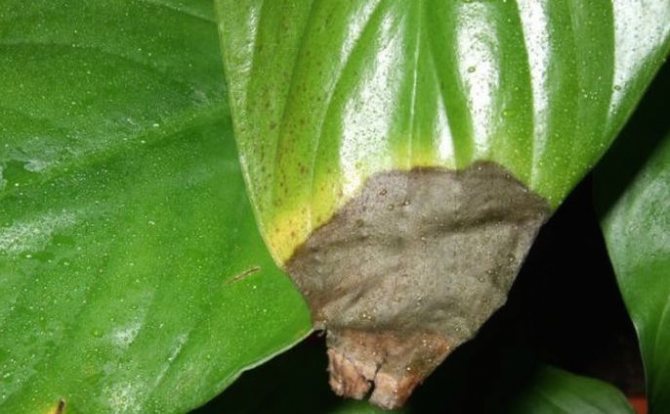

"Sick" leaf of spathiphyllum
There are a number of diseases that spathiphyllum is susceptible to. The plant, with proper treatment, can be saved.
Flower diseases:
Chlorosis of leaves occurs as a result of an excess amount of fertilizer in the soil.It is required to normalize the composition of the soil. Gommoz infects the plant with dangerous viruses and bacteria. Dark areas should be removed and adjacent leaves should be wiped with soapy water. Root rot occurs as a result of waterlogging of the soil. It is necessary to dry the soil and thin out the bark system. When fungal diseases an effective way would be to treat the flower with sulfur powder.
As a preventive measure, the plant should be inspected regularly. If suspicious symptoms are found, treatment should be started. You can temporarily move the flower to another room so that neighboring indoor plants do not get sick. Also, for preventive purposes, you can treat with chemicals to avoid the appearance of diseases.
Subsorts and their photos
The Wallis flower includes 40 varieties that are also in demand, and here are some of them:
Cladius
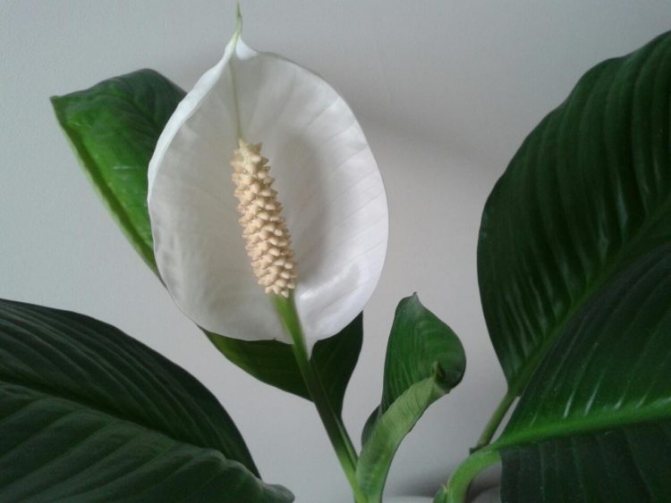

Differs in compact dimensions up to 30 cm.
Chopin
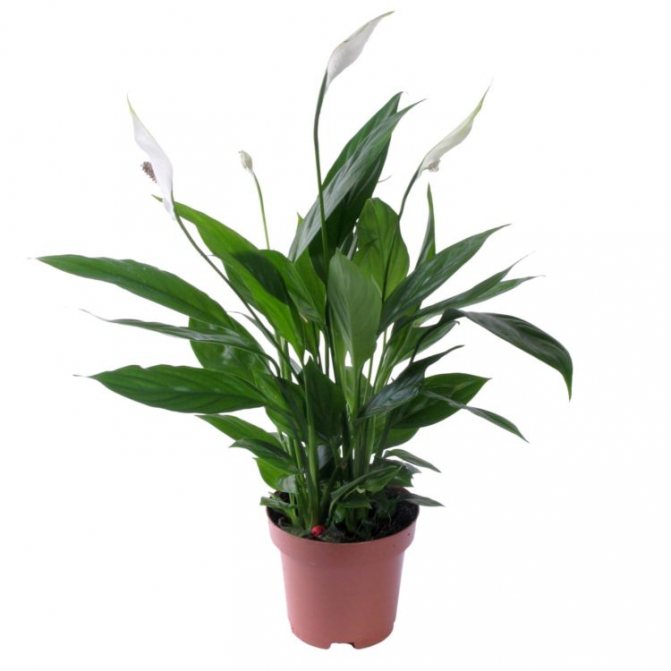

Chopin has a decent length of bedspread.
Mozart
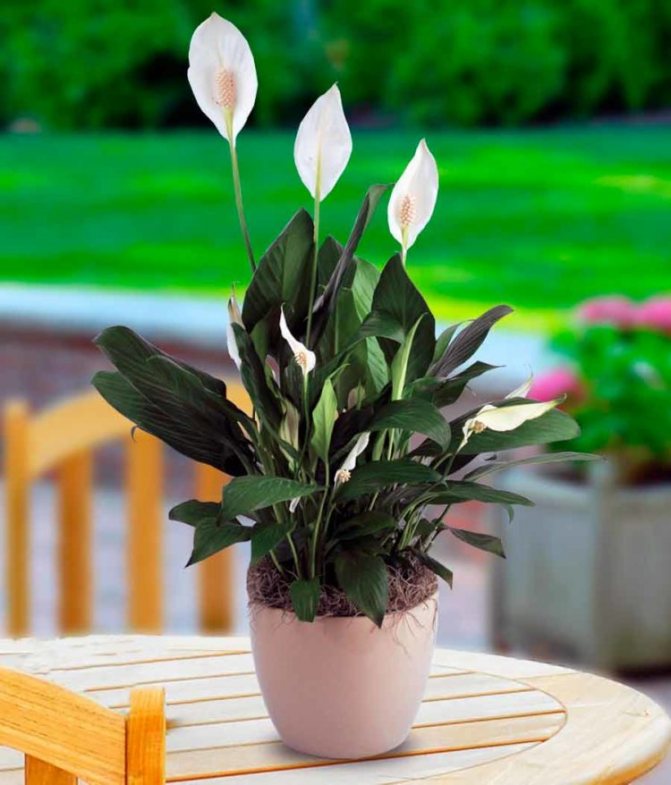

The bush is not large, it stands out with narrow lanceolate leaves.
Macho
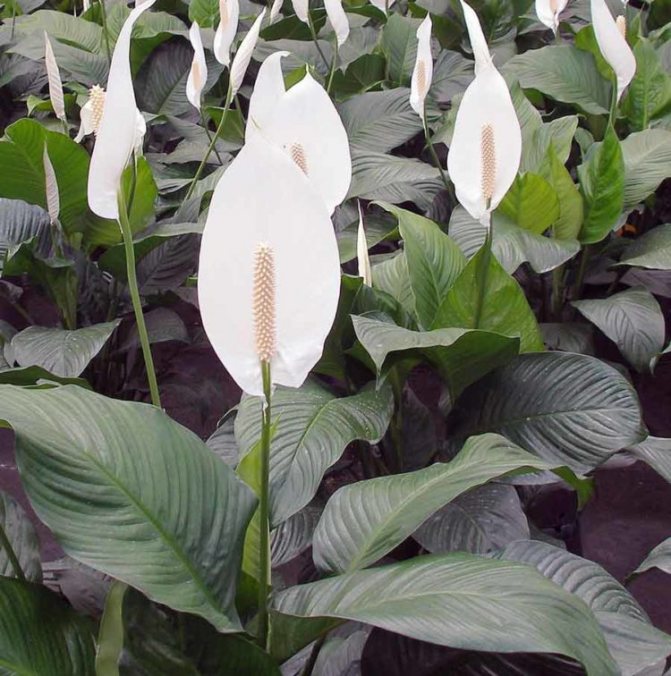

There is a fairly elongated bedspread.
Numero Uno
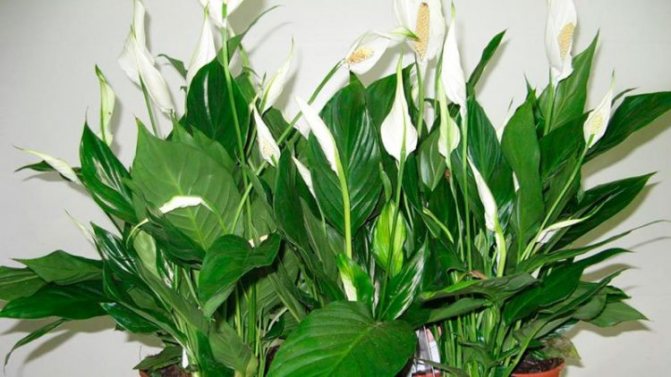

The variety was bred recently, depending on the light, the color of the leaves can be monotonous or variegated.
Florin
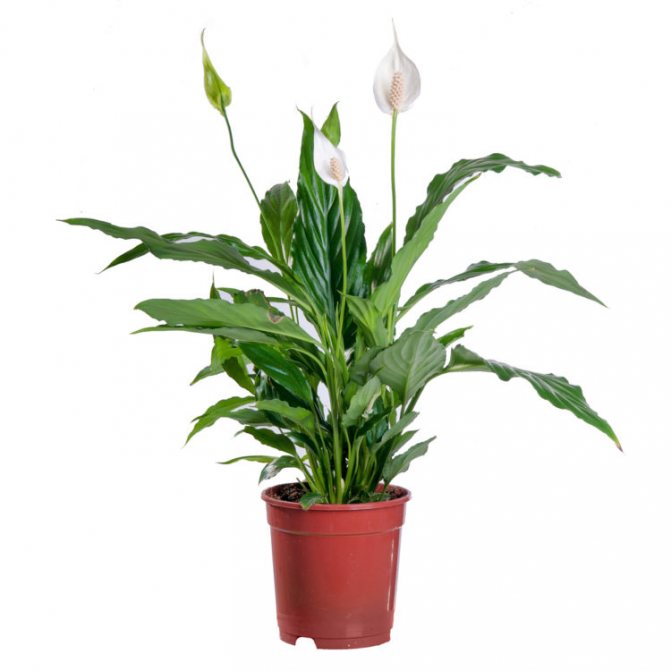

It features medium-sized round foliage, suitable for small rooms.
Sweet Silvio
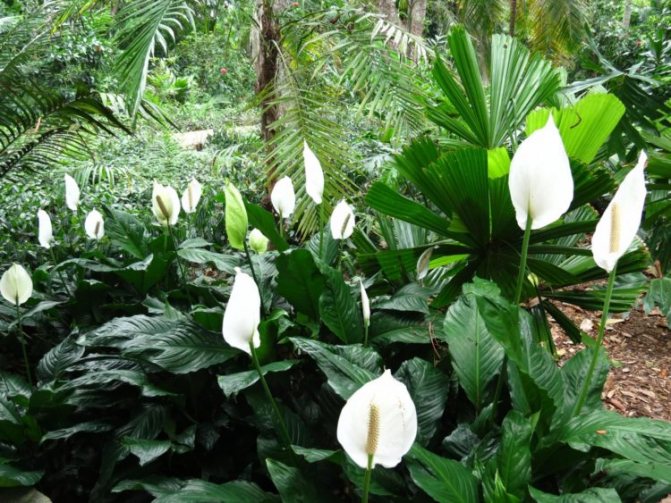

An interesting species, which has large, dark green leaves and a pleasant, delicate aroma of inflorescences. You can read about this and other varieties of Spathiphyllum Sweet here.
Our experts have prepared for you a number of articles about the varieties of spathiphyllum, among them the beautiful Cupido, the miniature Strauss, the adorable Domino, the delicate Sensation and Alana, the amazing Picasso, as well as the popular white varieties of the plant.
Signs and superstitions associated with Women's happiness
From the popular name of the plant, it becomes clear that all the signs and superstitions regarding it are associated with women. For most of the fair sex, the main happiness in life is their children, therefore it is believed that the bush protects babies and gives them health.
It is also generally accepted that it is useful to plant an indoor flower for those girls who dream of getting pregnant. Even if the pregnancy has already begun, spathiphyllum will facilitate the bearing of a child, reduce the manifestations of toxicosis and contribute to the successful resolution of the burden. The sign associated with pregnancy appeared for a reason. It was noticed that the cover of the flower on the back side is similar to the belly of a pregnant woman.
When to transplant?
Having become the owners of "female happiness", many are wondering when to transplant it. This is advisable in the following cases:
- The plant was recently brought from the store.
- The flower has drooping leaves and a generally unhealthy appearance.
- His age is 1 year.
- Spathiphyllum has not been transplanted for 2-3 years.
- The roots have grown into the drainage holes of the vessel.
- The plant does not bloom for a long time.
The best time for transplanting is considered the beginning of spring and the end of winter. If this procedure is urgently needed, then it can be carried out at any time of the year.
Useful video
We offer you to watch a video about the features of caring for spathiphyllum:
If you find an error, please select a piece of text and press Ctrl + Enter.
The houseplant "female happiness" is very popular among amateur flower growers due to its beautiful flowering. Subject to the rules of care, the flower will delight with its beauty, and the simplicity of reproduction will make it possible to increase the number of copies both in the house and in the office.
Spathiphyllum belongs to the Aroid family, native to the tropics of South and Central America, Indonesia and the Philippine Islands. It was introduced to Europe in the 19th century for indoor breeding. The name consists of two Greek words: "spatha" and "phyllum". In translation, they mean "cover" and "leaf".
The name accurately reflects the unusual structure of the inflorescence: a snow-white veil of the petal envelops a yellow ear.Due to its appearance, spathiphyllum received a second name - "white sail", "sail of love". It is also called “female happiness”, since there is a belief that he helps unmarried girls find a soul mate, and who already has a husband, keeps a family, and helps infertile couples to have a child.
The flower has a shortened rhizome, elongated petioles, close-knit rosette. Shiny leaves are lanceolate or oval in shape of a rich green hue, can have a pale greenish color, there are variegated colors. A central vein passes on the leaf plate, from which veins diverge. The inflorescence protrudes a few centimeters above the leaves, the bracts have a greenish tint on the outside, and white on the inside.
The peculiarity of the Aroids is toxicity: the leaves contain calcium oxalate. Some allergy sufferers can cause dermatitis if they touch them. Useful quality of Spathiphyllum - it cleans the air from harmful substances: ethanol, toluene, formaldehyde, carbon monoxide. True, the plant itself does not tolerate smoky rooms and gas. For high-quality purification of the air in the room, there should be at least six copies, it is not difficult to grow new ones.
According to various sources, from 35 to 45 species of Spathiphyllum are found in the wild. For home conditions, many species have been bred, among which there are compact, medium and high varieties: Abundant flowering, Japanese, Wallis, etc. Some specimens reach a height of 1.5 meters. Varieties differ in flowering time: some bloom once a year, others - all year round.
Spathiphyllum is not susceptible to infections, but its health needs to be monitored. Although he rarely gets sick, pests can infect him, so it is important to detect them in time and take action. The following insects are dangerous:
- Aphid. It can be found by drying curled leaves. Pests spread very rapidly, so action must be taken immediately. We fight aphids with nicotine sulfate, treating a bush with a means. Before cultivation, cover the soil in the pot with plastic wrap. It may be necessary to repeat the attack on aphids, since it cannot be destroyed the first time.
- Spider mite. Signs of damage are weightless spider webs and yellowed leaves. We carefully collect all the cobwebs, treat the leaves with onion husk tincture, soapy water, do the treatment with insecticides or ground sulfur. After processing, wash the bush with warm water.
- Shield. After insects, dark spots remain on the entire plant. We fight with a tobacco-soap solution. We process only stains, you do not need to touch healthy areas. After the procedure, we arrange the same warm shower as in the previous case.
- Mealybug. Pests appear at high humidity. Insects are easy to spot on examination. If there are few of them, it is enough to wipe the leaves with a napkin dipped in an alcohol solution. In case of significant damage, we use special chemicals: insecticides (green soap, Aktara, Fitoverm) and acaricides (Sunmayt, Aktellik, Flumite).
If the ends of the leaves dry out, this indicates a lack of moisture. To restore their healthy appearance, it is necessary to spray the bush with water more often. When waterlogged, dry yellow-brown spots appear on the surface of the leaf plates. In this case, you need to reduce the frequency of watering. If the leaves turn black, this is a sign of a diseased root. A transplant is required.
If the edges of the leaves turn black and dry over time, this indicates that the flower lacks nutrients, it must be fed. To enrich the soil, we apply nitrogen-phosphorus fertilizers. If the leaves curl, then the plant is cold. The lack of heat and light is indicated by the shade of the bract: it is usually greenish, and with improper care it becomes excessively green.
In the wild, Spathiphyllum grows in the forest tropics on the banks of small rivers and streams, so we create conditions for it that are as close to natural as possible: warmth, partial shade, humid air. Since there is a lot of shade from trees in the rainforest, the flower is ideal for those flower growers who do not have the opportunity to place flowerpots on the sunny side. With the help of lighting, you can adjust the shape and color of the leaves. If the pot is in a well-lit place, the leaves will be wider and lighter in color; when in a dark room, they become a rich green hue and stretch out.
In insufficient light, Spathiphyllum will not bloom, so you should carefully monitor its behavior after purchase in order to create optimal conditions and get not only a beautiful green bush, but also abundant, long flowering. On the windows on the north side, the flowers are more comfortable, but on the south side, the flowering is longer and more abundant, however, it is necessary to protect the plant from direct sunlight so that the leaves do not get burned.
The thermal regime is to keep Spathiphyllum from freezing in winter. Naturally, in a warm apartment he will not be cold, but he needs to be removed from an unheated room, for example, a hallway. Even a temperature of +10 degrees will be critical for him, he will start to rot, it will be impossible to restore it. The minimum temperature at which Spathiphyllum will feel comfortable is +16 degrees. If the room temperature is lower, it must be raised at least with a thermal fan. For the normal development of the plant, the temperature is maintained at about +22 degrees. We exclude drafts, as they are destructive.
Spathiphyllum watering and home care has its own characteristics due to the specific structure of the flower. It does not have stems, the leaves grow from the very root, moisture is obtained immediately after watering. Therefore, we water only after the soil has completely dried. With frequent watering, water can stagnate, which will lead to rotting of the base of the bush.
To get a healthy flower, you need to water it with settled water all year round. When watering, we make sure that the liquid falls only on the soil. In different periods, watering differs in frequency and abundance. During flowering, regardless of the season, we water often and abundantly, and during the rest period - in winter, watering is done moderate and rare, once every two weeks. After watering from the pan, pour out the excess water that has collected in it. It is reasonable to maintain the water balance through the sump, add water to it when the top layer is dry. We make sure that the roots do not dry out, otherwise it will be difficult to restore the root system. To increase the humidity, the pot can be placed on wet expanded clay or pebbles.
This indoor flower is a tropical plant, therefore it loves a humid climate.
To create the appropriate humidity for it, we regularly spray the bush from a spray bottle with settled water at room temperature. We spray the bush, depending on the place where it is, either early in the morning or in the evening before sunset. In the summer heat, we irrigate the leaves two, maybe even three times a day. If Spathiphyllum is in bloom, the droplets should be kept away from the ears and bedspread.
Watering
Spathiphyllum is watered sparingly, allowing the top layer of the earth to dry out a little before the next watering. The earth should not dry out completely. At temperatures below 15 degrees, you need to limit watering. Too intensive watering causes yellowing and wilting of leaves, insufficient watering, wilting of leaves and flowers. Place the pot in a container of water so that the root ball can absorb the water. Then take out the pot so that excess water flows out through the holes in the bottom.
Natural conditions
To understand how to successfully grow "female happiness", you should familiarize yourself with the conditions in which this plant grows in nature.Spathiphyllum is native to the South American and Malaysian rainforests. Favorite growing places are flooded or swampy areas, the banks of reservoirs.
That is, in the usual habitat - high air humidity, loose and damp slightly acidic soil. In such conditions, "female happiness" successfully grows and blooms. And what is the conclusion from this? What soil is suitable for spathiphyllum? In the natural environment, the soil includes fallen leaves, rotten branches, charcoal and compost. Based on this knowledge, you can make your own nutritional formula.
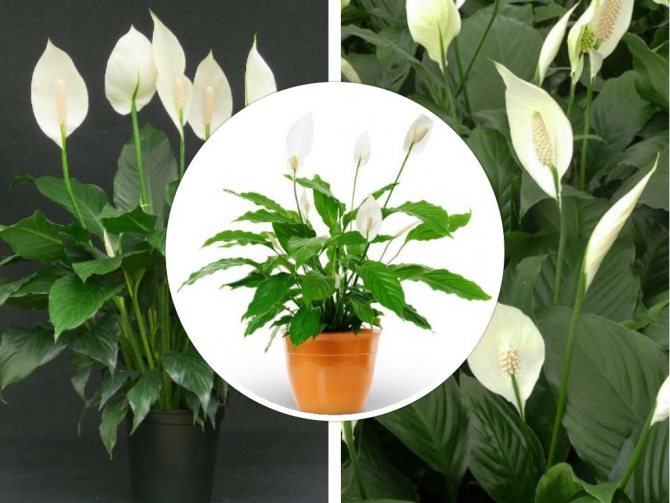

History of appearance
The flower was first noticed by the German botanist Gustav Wallis in Colombia in the 19th century. In the middle of the twentieth century, this plant was introduced to Europe and has since been grown as an indoor plant.
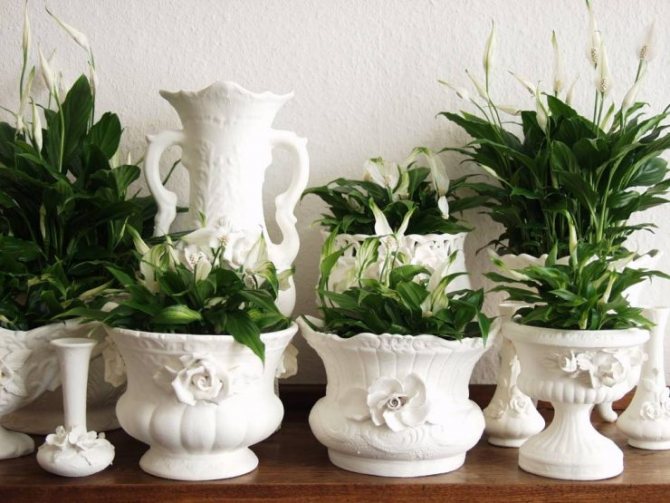

Spathiphyllum in the interior
Spathiphyllum the homeland of the plant is South America, East Asia, Polynesia.
Pot selection
It is important to know which pot is needed for spathiphyllum. Due to the wrong choice, it will hurt or stop blooming.
This plant prefers tight spaces, so you need to take the appropriate vessel - small and shallow. If there is a lot of space, then flowering will not happen soon. It usually starts when the roots take up the entire container.
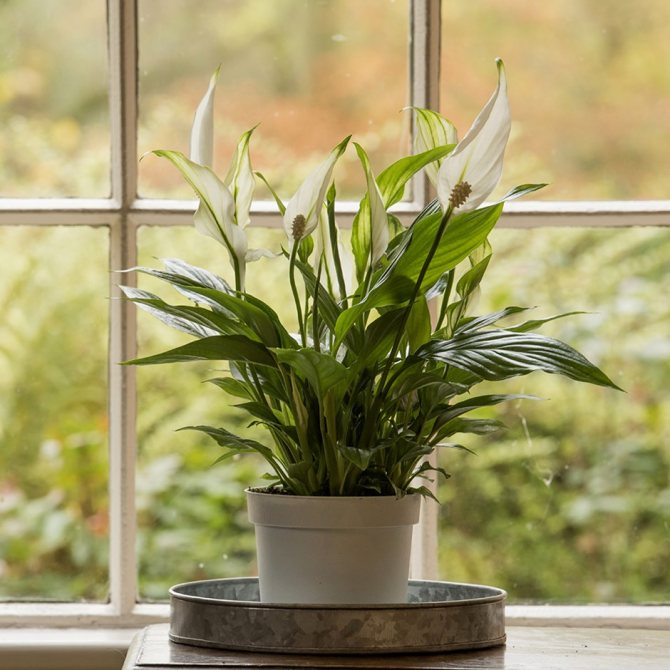

When the spathiphyllum reaches a height of 30-40 centimeters, the transplant must be stopped. For such a green pet, a container with a diameter of 17-20 centimeters will be optimal.
The material of the pot does not matter. But for large specimens, it is advisable to take a more stable vessel. For example, a ceramic tub or pot. There must be drainage holes to drain excess water.
Important nuances
Pay attention to the following recommendations from experienced florists:
- The substrate for "female happiness" must be slightly acidic. Optimum values are 5-6 pH.
- It is recommended to use a soil containing charcoal. It is an excellent antiseptic and can prevent root rot in case of waterlogging.
- Self-prepared soil must be disinfected. To do this, you can use a hot solution of dark pink potassium permanganate.
Pruning
Pruning spathiphyllum is done after flowering ends. The old peduncle is removed, as well as yellowed or dried leaves of the plant. This procedure is carried out so that nutrients are not consumed on the faded peduncle.
Pruning should be done with a clerical knife. This will make the cut neat. Pruning with scissors damages plant tissue, which can lead to infection. Slices are necessarily processed with crushed activated carbon.
Pruning should be done as close to the root as possible.
Effects
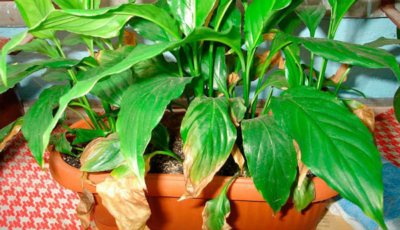

With improper care, spathiphyllum can get sick or die. The lack of flowering also indicates that the care of the flower is being done incorrectly.
A healthy plant with bright green leaves and regular flowering. In the absence of the necessary dressing, the flower may not bloom at the right time, and differ in scanty leaf formation.
If you use the recommendations described in the article, spathiphyllum will live a long time, delighting with regular flowering. Compliance with simple care rules will help avoid possible problems. In the event of any change in plant condition or disease, immediate action should be taken. In general "Female happiness" is a very unpretentious plant.
Varieties
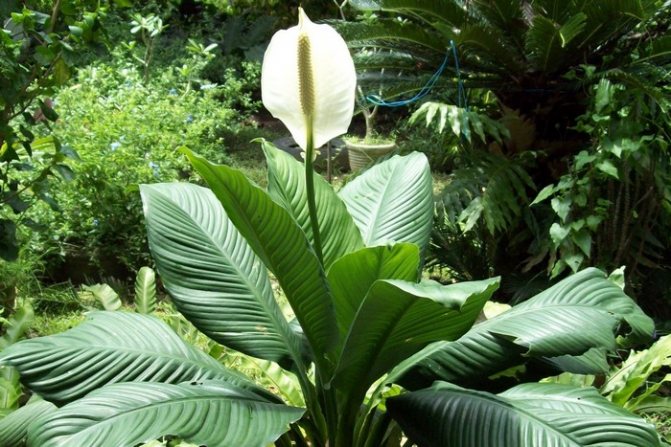

- Cleveland - narrow and long leaves;
- Mauna Loa - wider leaf blades, grows about 35 cm tall;
- Sensation - high grade, grows 130-180 cm tall, large and wide leaves;
- Euro Giant is a tall variety with large leaves, grows 1 m tall;
- Gemini is a variety with variegated leaves;
- Yess - a variety with small leaves, grows 25-45 cm tall;
- Svit Silvio - reaches 60-80 cm in height, broad leaves of medium size.
First steps after buying spathiphyllum
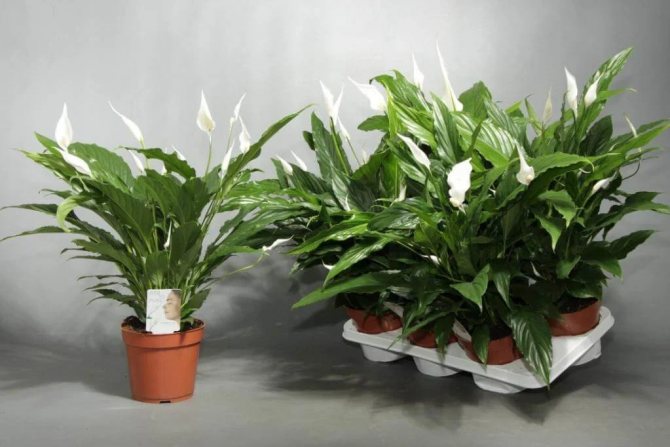

Although the bush is sold in a temporary pot and a light substrate, they are in no hurry to replant it after purchase. The flower is given two weeks to acclimatize to new conditions. And they put it away from the rest of the houseplants. This is the so-called quarantine. In a couple of weeks, it will become clear if the bush is not affected by parasites. After the specified period, if everything is fine, the flower is transplanted into a permanent pot, placed on a common window sill.
Landing
When planting spathiphyllum, it is very important to choose the right pot size and soil. Women's happiness grows best in a mixture of peat, sand, turf, leafy earth and humus.
Before placing a flower in a new container, it is imperative to inspect the root system. Rotten and damaged roots are removed. Cuts and wounds are treated with a solution of potassium permanganate and sprinkled with crushed activated carbon.
Also, when planting spathiphyllum, it is recommended to cut off old leaves and peduncles. This is done in order for the plant to take root better.
Answers to popular questions, or small secrets of success
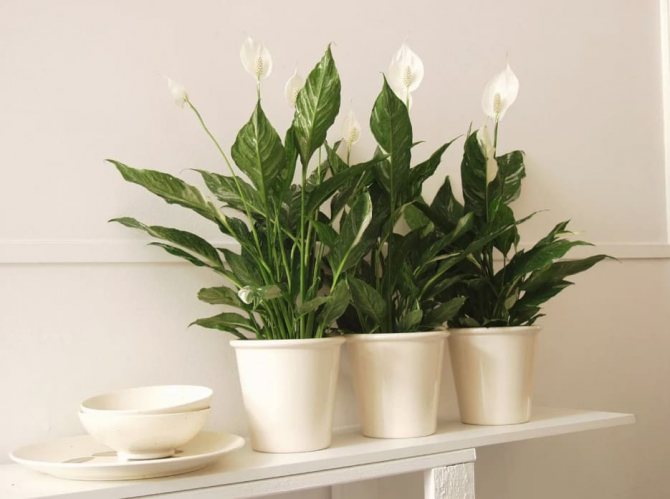

Spathiphyllum - decoration of any interior
Although spathiphyllum does not require extensive knowledge of floristry and is very unpretentious in care, many novice florists have a number of questions when growing this plant.
Why is it growing poorly?
If the flower looks healthy, its leaves and stems are green without black, yellow or brown spots, then the reason for the poor growth of spathiphyllum is an excess of sunlight and moisture in the soil.
Another reason is the pot is too big. Until the root system develops properly, the green part of the flower will not grow.
If you accidentally "flooded" spathiphyllum, then try to loosen the soil. This will give air access to the roots and allow the soil to dry out faster. If the ground remains wet for several days, then Women's Happiness will have to be transplanted into new soil.
Why does it fade?
There are several main reasons why spathiphyllum fades.
- Recent transplant - it is always stress for the plant. For some time it will get used to new conditions. It is possible that some of the leaves will look wilted.
- Wrong watering regime... Withering can also cause over-or under-watering. Much worse if you "flood" the flower. The plant will endure a slight drought and will look healthy again in a few days. Excess moisture is dangerous because the earth is crumpled, air stops flowing, and root decay begins.
- Change of location. Plants do not like very much when they are rearranged from place to place. A change in the microclimate has a negative effect primarily on the leaf plates and the peduncle, which begin to fade. Without a good reason, you should not rearrange the flower pot for a long time.
- Incorrect feeding regime. Novice flower growers very often think that the more fertilizers they apply, the more abundant the spathiphyllum will bloom. But this is a mistake. An excess of minerals negatively affects the plant. In particular, wilting processes are observed.
- Pests. If you are confident that you have properly cared for your pet, pick up the leaves of the flower. Most likely, insects breed under them. They must be removed from the leaf plates, and the plant itself must be treated with insecticides and soapy water.
How often does it bloom?
Women's happiness blooms once a season. Most often - from March to late August - early September. From October to February, the flower should be at rest. To do this, cut it off, reduce watering and feeding.
You should not artificially achieve year-round flowering of spathiphyllum. The dormant period is very important for the plant if you want it to delight you with lush flowers and live longer than a few years.
Constant flowering will quickly drain the plant. It will become more vulnerable to fungal and bacterial diseases.
How to care for leaves
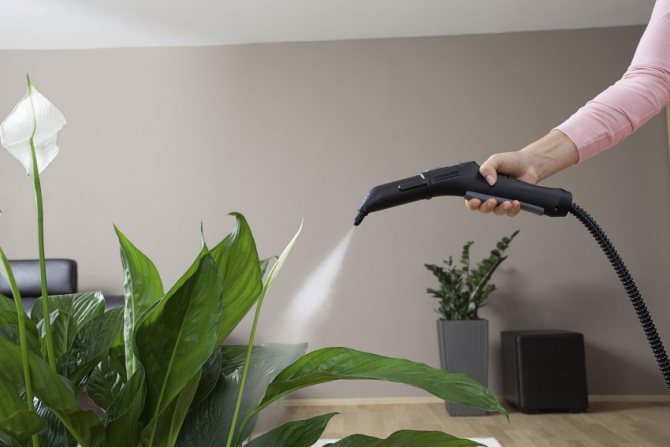

Spathiphyllum spraying
In spring and summer, spathiphyllum leaves should be sprayed with a spray bottle and wiped with a damp cloth. This is done to increase the overall moisture that this flower loves so much.
In autumn and winter, it is not necessary to spray the leaves with water, since the plant is dormant at this time of the year. Just dust the sheet plates from time to time with a cloth.
After the Feminine happiness has faded, you need to remove the old, yellowed, withered and dried leaves. This can be done while pruning the plant.
Why do the tips turn black?
If your spathiphyllum has blackened tips, it means that you "flooded" the plant or applied too much fertilizer.
In this case, you need to stop watering and feeding for a while. The soil in the pot must be loosened and dried. In the future, reduce the amount of fertilizer applied.
Why do flowers turn black?
The most common reason for the blackening of the flowers of Women's happiness is "wet hypothermia". That is, when the plant is watered in the evening and remains on the window with the window open. The water does not have time to be completely absorbed, the temperature drops at night, and the roots of the plant are supercooled.
In this case, it can be very difficult to save Women's happiness. The plant will have to be rearranged to a warmer place, and the roots should be treated with Kornevin.
Also, blackening of flowers can signal a fungal disease. In this case, the plant should be immediately quarantined and treated with fungicides, carefully examining the stems, leaves and roots.
Sometimes blackened flowers are the result of improper care. For example, non-compliance with the watering and feeding regime, too low temperature, dry air.
How to increase the number of buds?
There are several tricks to increase the number of buds on spathiphyllum.
Firstly, the plant should not have old inflorescences. Therefore, they will need to be removed.
Secondly, the flower pot is placed in a cold place for 15 days, and then returned back.
Thirdly, within a month, it is fertilized twice with mineral dressings.
Fourth, as soon as flowering begins, spathiphyllum is sprayed daily with warm water from a spray bottle. This must be done carefully so as not to get on the buds.
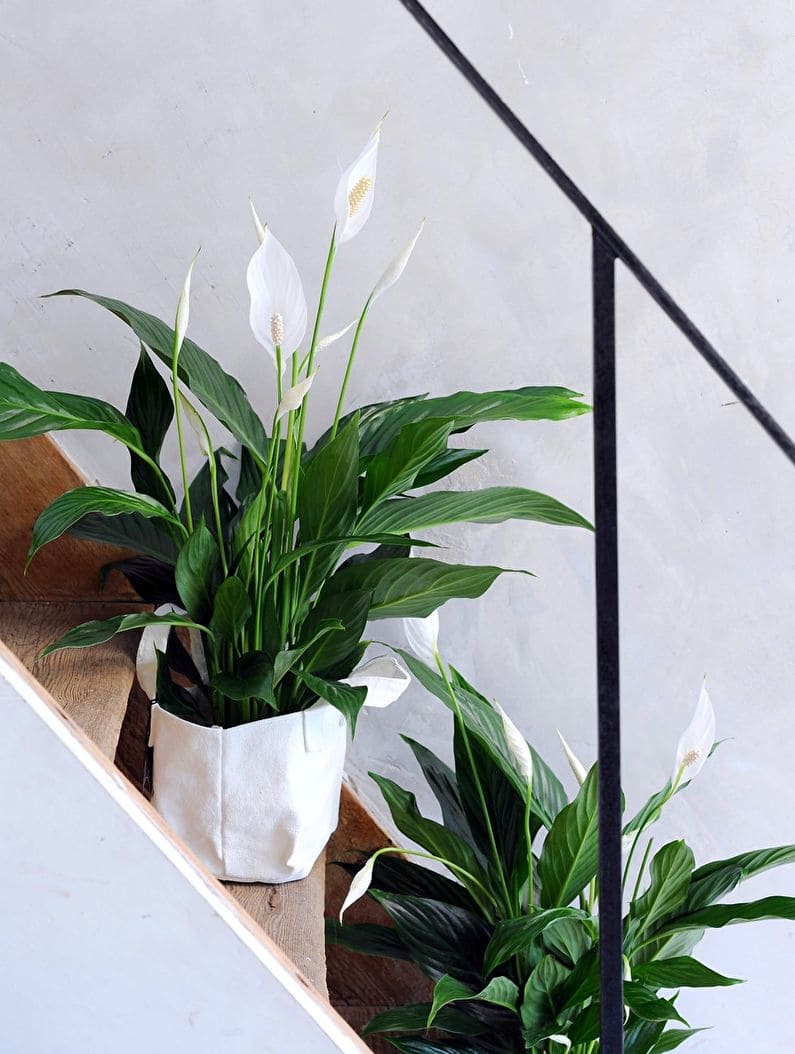

Spathiphyllum
Top dressing
Feminine happiness needs to be fed in accordance with the season. In the cold season, fertilizers need to be applied no more than once a month, and it is best to refrain from feeding altogether.
In spring and summer, the amount of dressing increases, since during the growth period the plant needs more nutrients. Therefore, at this time of the year, you need to feed the flower once every 2 weeks. This fertilization schedule continues until the end of flowering.
Spathiphyllum prefers organic fertilizers, but it perfectly accepts complex mineral fertilizers for flowers in a diluted form.
Proportions for soil compilation
The soil for "female happiness" must be loose and fertile. These are important conditions that must be observed when formulating the substrate. So, what kind of soil is suitable for spathiphyllum? There are several recipes:
1. Coniferous soils, sand, humus - in equal parts, garden soils - 2 parts, peat - 4 parts.
2. Garden soil and perlite - 2 parts each, peat and soil for orchids - 3 parts each.
3. Sod land - 2 parts, sheet soil, peat, coarse sand - 1 part, charcoal, clay brick chips - half of the part.
4. Sod land, river sand (or clay brick chips) - half a share, leafy soil, peat - 1 share.
5. Peat, humus, unmilled leaf humus - 2 shares, a mixture of charcoal, crushed bark, coarse sand and brick chips - 1 share.
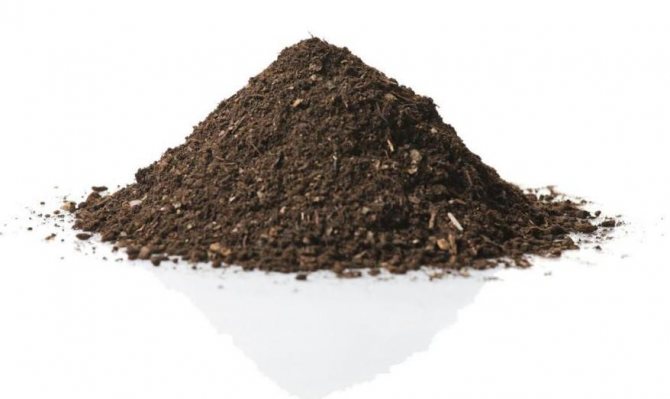

These formulations are well suited for "female happiness". The soil is nutritious, moisture-absorbing, oxygenated and not too acidic. It is helpful to add some coconut fiber to improve aeration. There are other soil options for spathiphyllum. Which components are suitable depends on the flower itself and the conditions of detention. The perfect recipe can only be found empirically. The main thing is not to forget about good drainage in order to avoid root rot.



